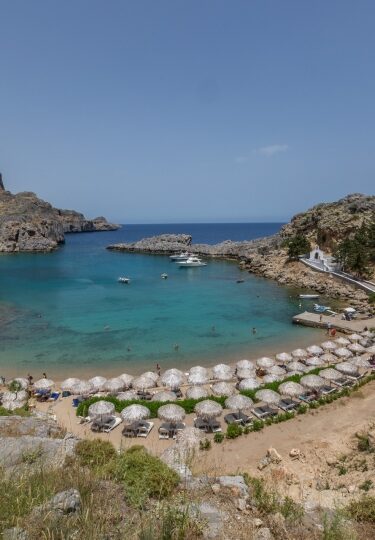With some 8,500 miles of coastline and more than 6,000 islands and islets, Greece is not a country that is short on beaches.
From small, rocky coves and sheltered bays with golden sands, to chic strands with sun loungers, umbrellas, and DJs, there’s a beach in Greece to please everyone. And where there’s a beach, there will usually be a taverna where you can sit with your toes in the sand, feasting on the catch of the day.
Here are some of the best beaches in Greece.
Vouliagmeni Beach, Athens
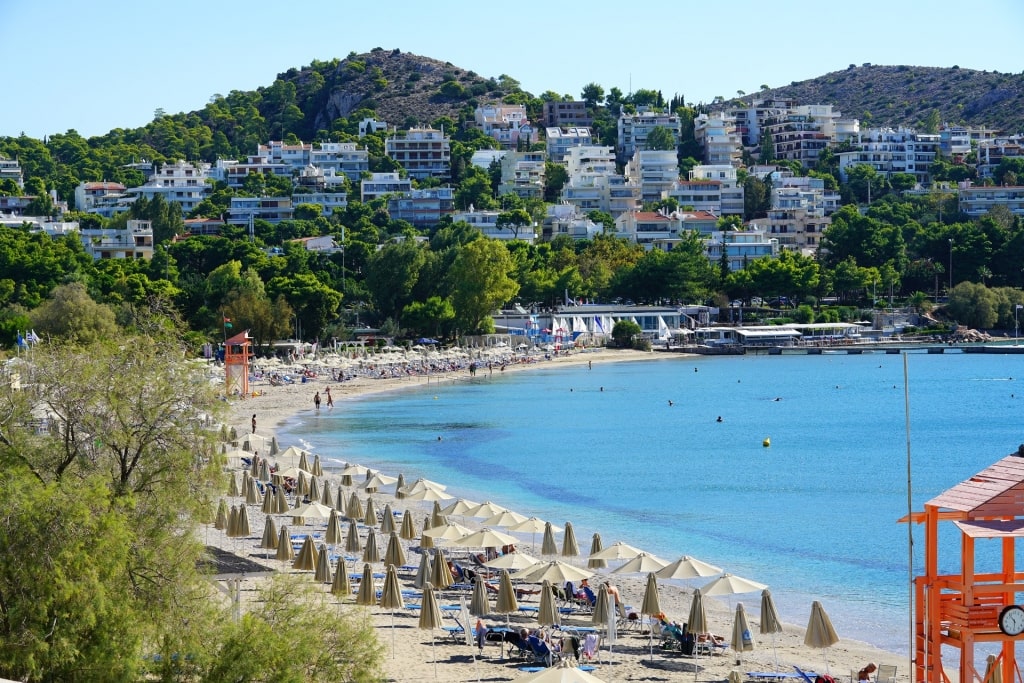
Vouliagmeni Beach, Athens
The beaches of Athens get better the further down the Athenian Riviera you get from the port of Piraeus, particularly if you head south-east on the coast road in the direction of the legendary temple of Poseidon at Cape Sounion.
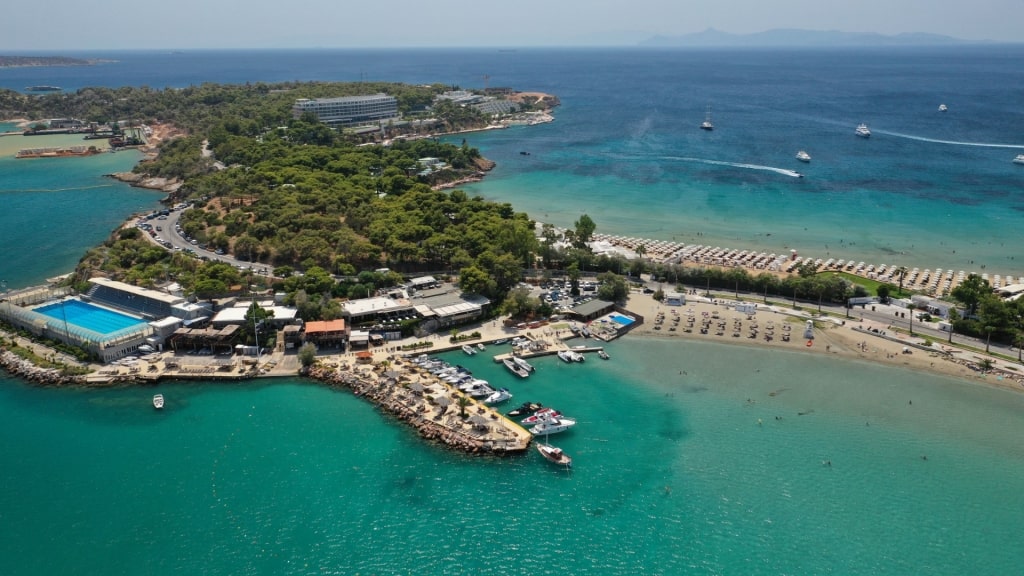
Vouliagmeni
The long and winding road eventually leaves the urban sprawl behind as it enters the high-end coastal suburbs such as Glyfada and Voula. A few miles further on and you arrive at the opulent resort of Vouliagmeni, where the public beach is a summer hangout of choice for well-heeled Athenians.
One of Athens’ best beaches, Vouliagmeni is set on an almost perfectly shaped arc, from where the shore shelves gently, making this an ideal spot for new or timid swimmers. You’ll find sports facilities, including beach volleyball and racquetball, as well as a choice of fine fish tavernas for lunch.
Read: Unforgettable Day Trips From Athens
Balos Beach Lagoon, Chania, Crete
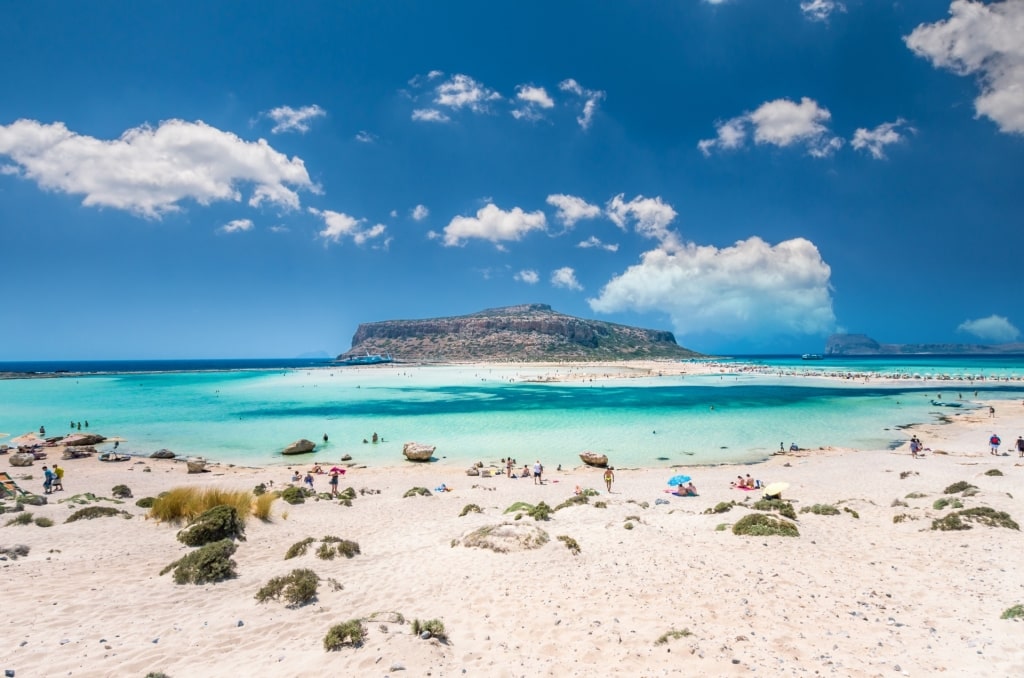
Balos Beach Lagoon in Chania, Crete
Sitting at the top of a rocky peninsula that juts into the Mediterranean, Balos Beach in Chania has a real sense of remoteness.
The approach, either by tortuous mountain road or boat, makes getting here feel like a trek, but it’s certainly worth the effort. Set around a lagoon, the sands are almost ice-white, kissed by warm, shallow, and calm seas.
A smaller spit of land, topped by a barren hill, juts into the water and offers myriad tiny coves meaning that even in peak season it can feel as though you have your own perfect stretch of sand to yourself.
Vidos Island, Corfu
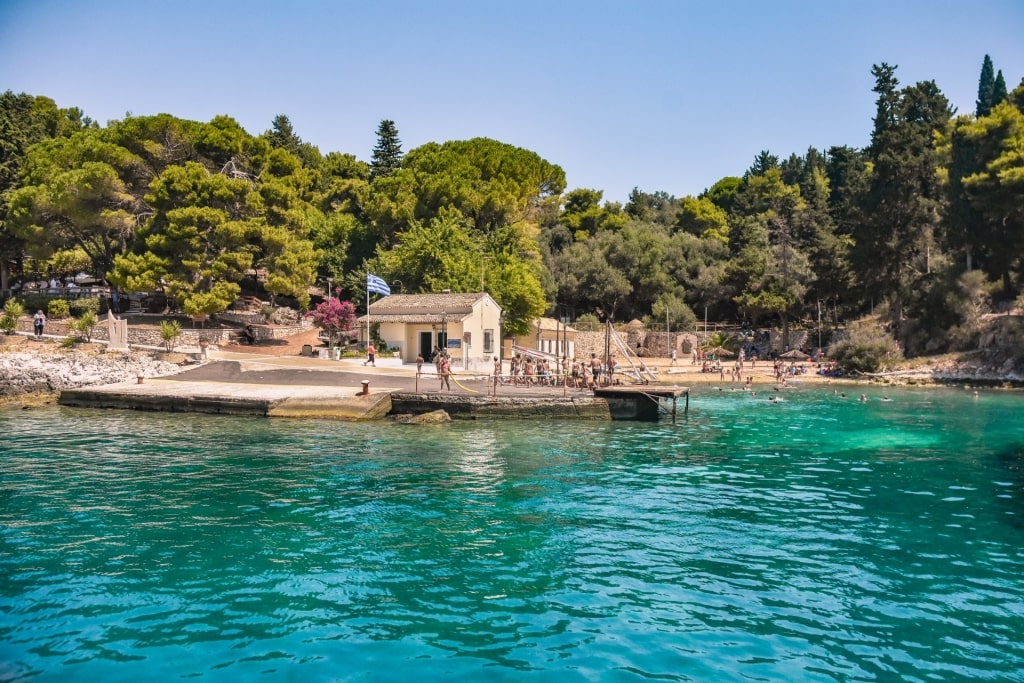
Vidos Island, Corfu
The Mediterranean island of Corfu has a number of fine beaches, but to see what Greece was like 50 years ago, pay a visit to Vidos Island.
Set off the coast of Corfu Town, this tiny islet was known in the past as Greece’s Alcatraz as it once housed a prison. Since 1993, though, it has been designated a nature reserve.
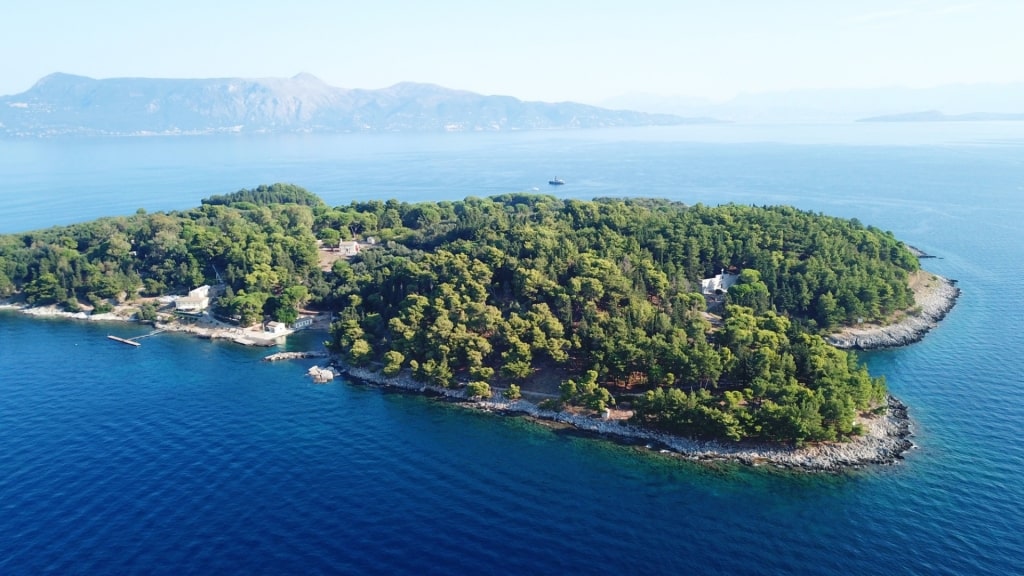
Vidos Island, Corfu
Densely wooded, with no cars and just one small taverna, the island is easy to explore thanks to fine hiking trails that lead to a remote beach to the north shore, perfect for getting away from it all in the height of summer.
Kourouta Beach, Katakolon
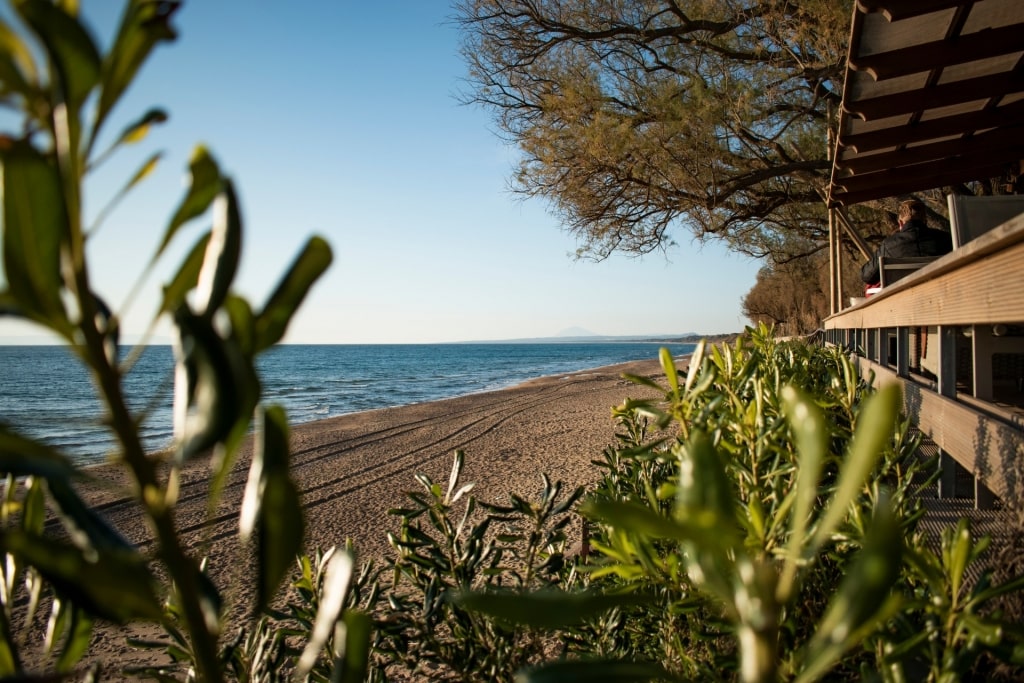
Kourouta Beach, Katakolon
Kourouta sits in the middle of a long stretch of pale ochre sand that hugs the west coast of the Peloponnese north of the port town of Katakolon.
Backed by a small village shaded by pine trees, it’s the one part of this long arc that is the most organized, with sun loungers and umbrellas, as well as beach bars right on the sand where you can sip ouzo and dine on fresh fish.
While most people use Katakolon as a jumping-off point for historic Olympia, if you’ve already been, or have kids in tow, a day at the beach is a great alternative.
Psarou Beach, Mykonos
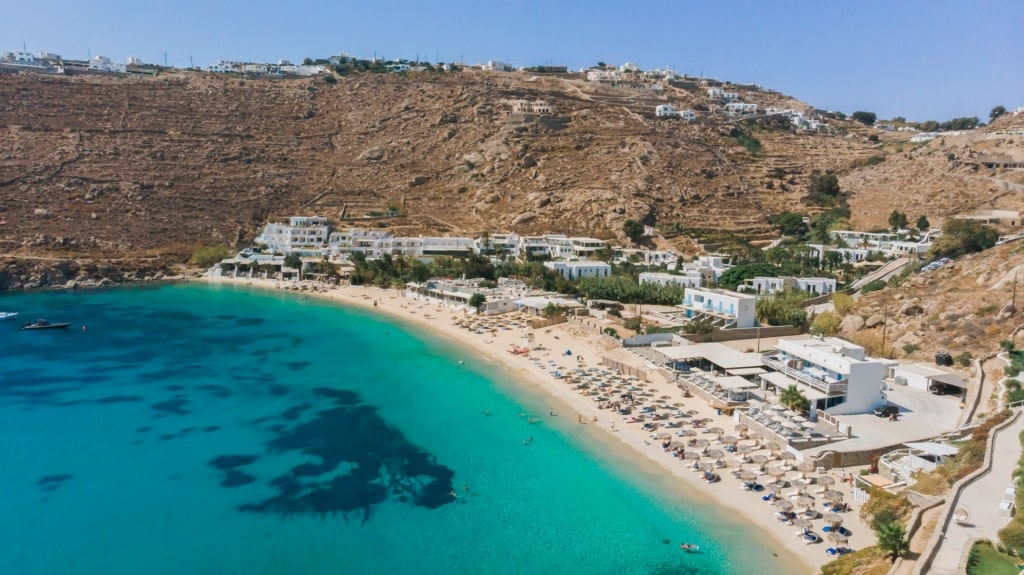
Psarou Beach, Mykonos
Psarou is the most upscale of a series of beaches on the southern edge of Mykonos, most of which are connected by water taxi from Ornos, just outside the main town of Chora.
Craggy hills frame a strip of pale golden sand at either end. Chic, whitewashed villas and hotels are scattered along the coast.
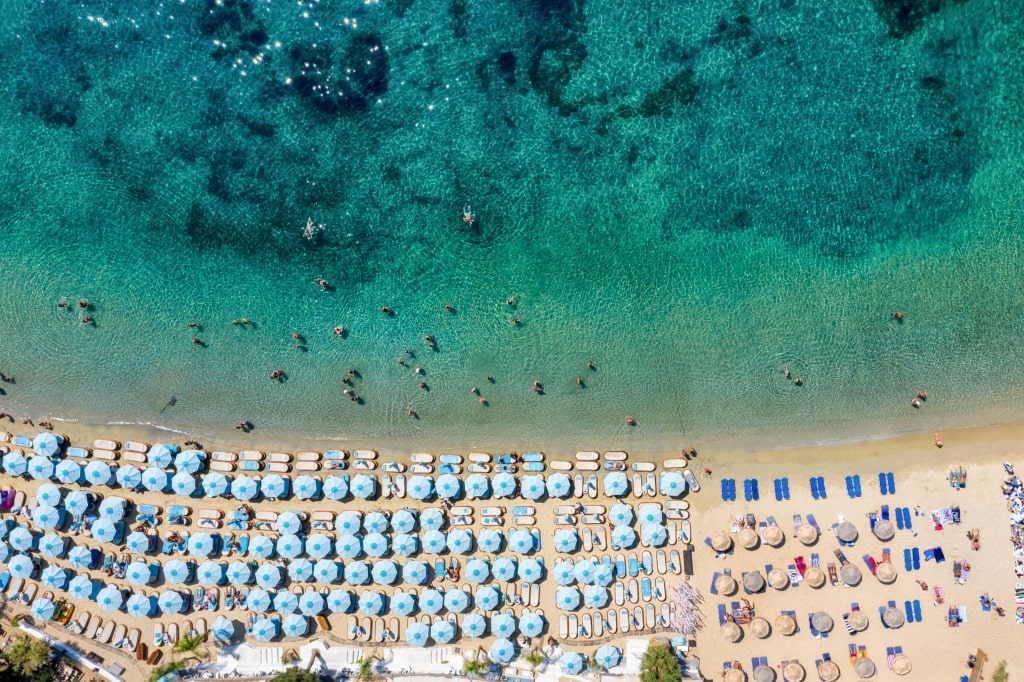
Psarou Beach, Mykonos
Given Mykonos’s reputation as one of the best Greek islands for beaches and nightlife, there’s a vibrant feel here. This is largely thanks to it being home to Nammos, a chic beach bar offering high-end dining, upscale shopping and table service at the sun loungers and umbrellas.
If people-watching is your thing, Nammos is the place to go on Mykonos, but there’s an equally fine stretch of public beach here too if you’re after a more low-key feel.
Kallithea Beach, Rhodes
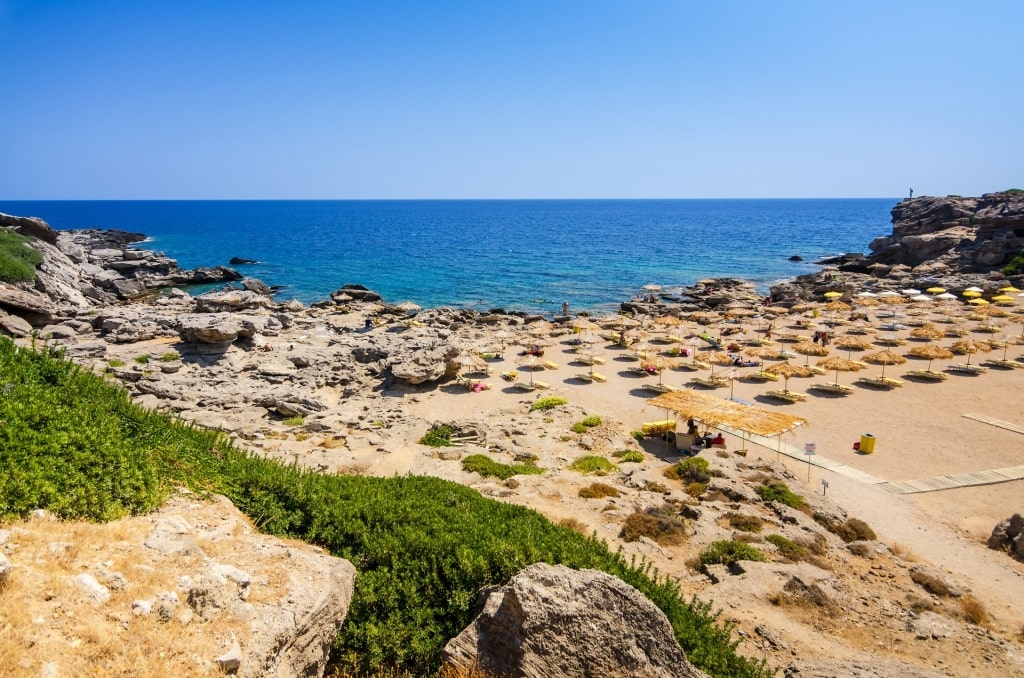
Kallithea Beach, Rhodes
Rhodes is another island famed for its beaches, with Kallithea being a great choice as it offers two options for visitors.
On the one hand, there is a wide stretch of public beach here, great for snorkeling, thanks to it being flanked by rocky outcrops. On the other, there is Kallithea Springs.
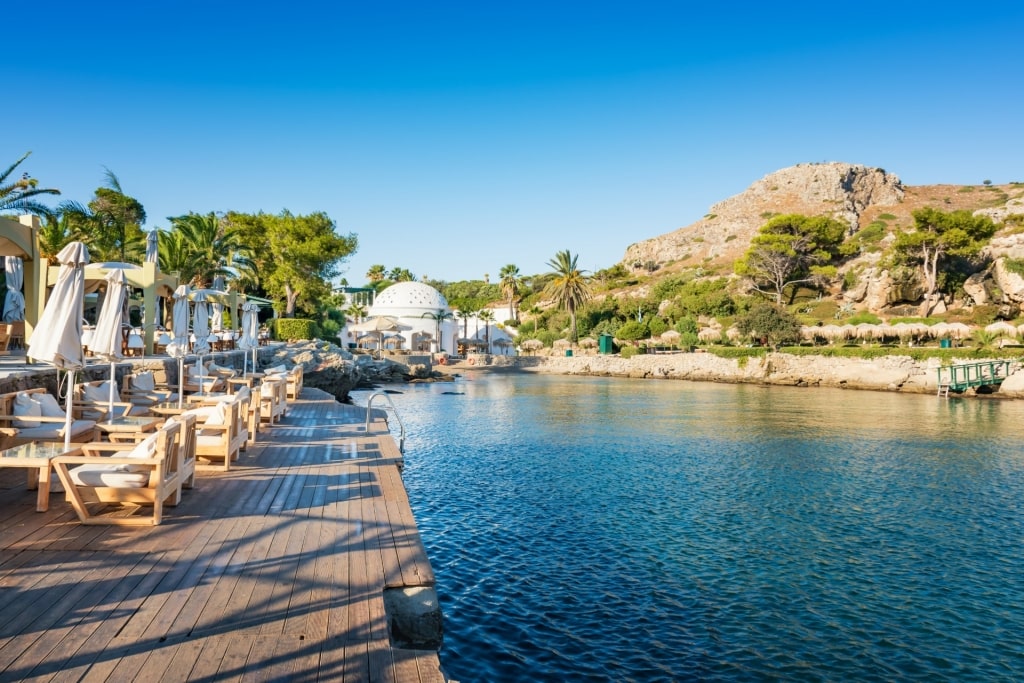
Kallithea Springs, Rhodes
This thermal baths complex has been restored to its opulent 1930s glory and features mosaics, hydrotherapy pools, a restaurant, gardens and a private beach. It’s a great place to spend the day, bathing and dining.
Read: Best Beach Destinations in Europe
Perissa Beach, Santorini
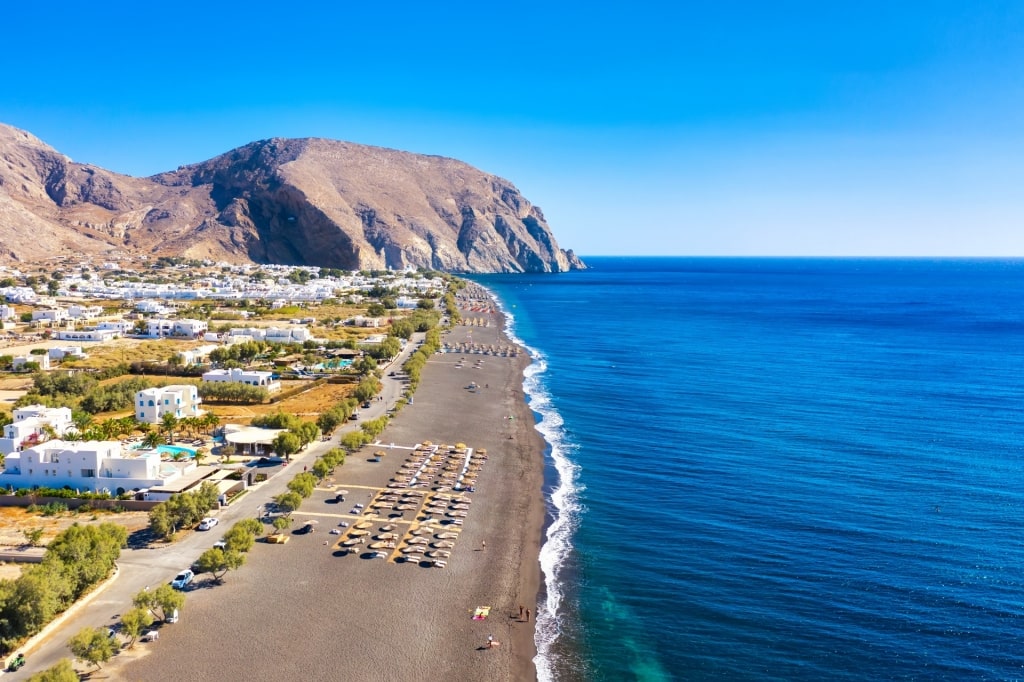
Perissa Beach, Santorini
On an island with so many classic photo opportunities, Perissa Beach sometimes misses out, which is a shame as it’s one of Santorini’s most iconic sights thanks to its black volcanic sand.
Stretching along most of the south coast of Santorini, the beach takes its distinctive color from the erosion of charred lava and the waters that lap it make for excellent swimming and snorkeling.
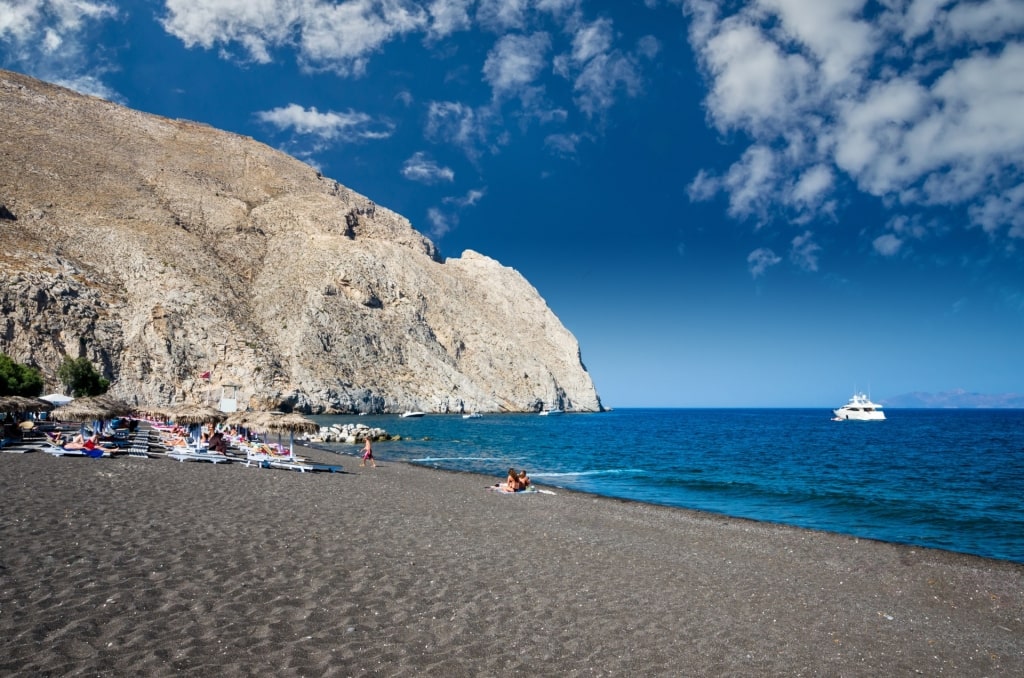
Perissa Beach, Santorini
A number of water sports centers operate from the beach, and there’s also a dive school for those who wish to take in a protected reef just off shore. Make sure to pack beach shoes for a visit—the black sand beach in summer can be scorching hot.
Vlychos Beach, Hydra
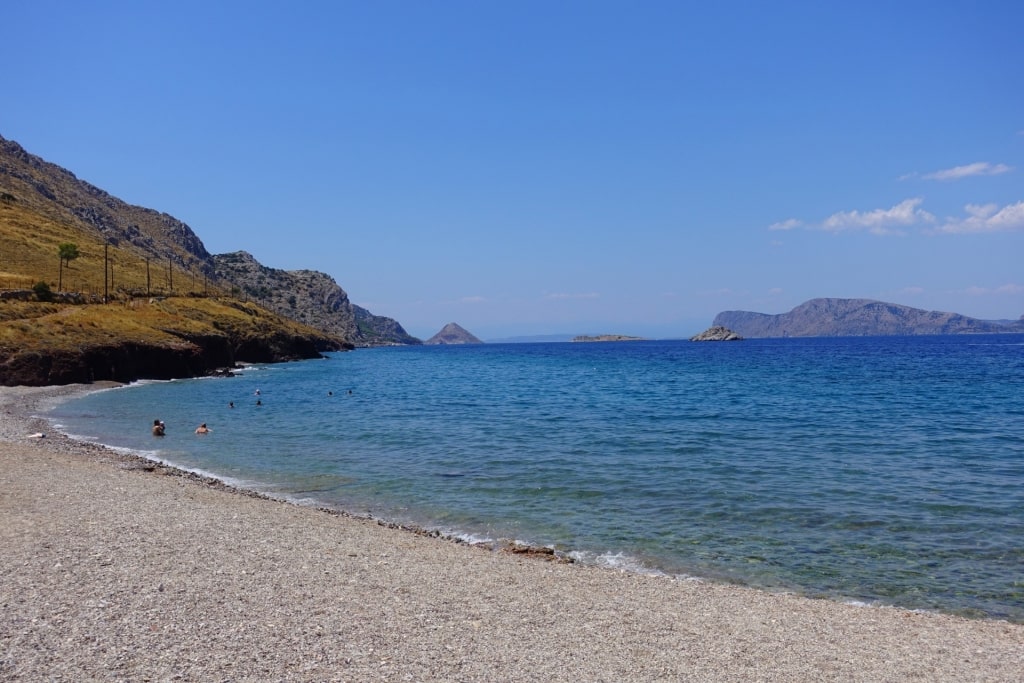
Vlychos Beach, Hydra
Hydra is rightly lauded as one of the most unique places to visit in Greece, largely thanks to its incredible port, a natural amphitheater lined with neoclassical mansions that historically belonged to the many sea captains who resided here.
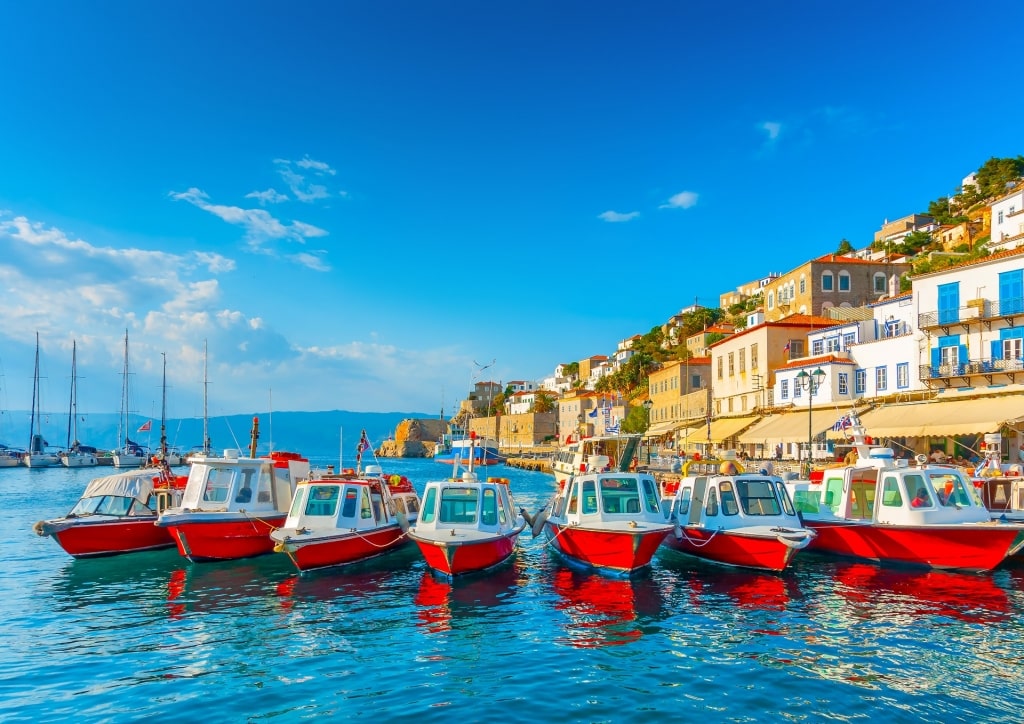
Hydra
Hydra is car-free and the only way to access its beaches is by water taxi or donkey. Vlychos is one of the most easily accessible from the town and also the island’s best.
A small stretch of sand with a gently shelving shore, it’s great for families, plus there’s waiter service at the sun loungers, and outdoor showers.
You can even walk from the town; it’s less than a mile, but arid Hydra has little shade, so take drinking water.
Read: Best Greek Islands for Families
Arvanitia Beach, Nafplio
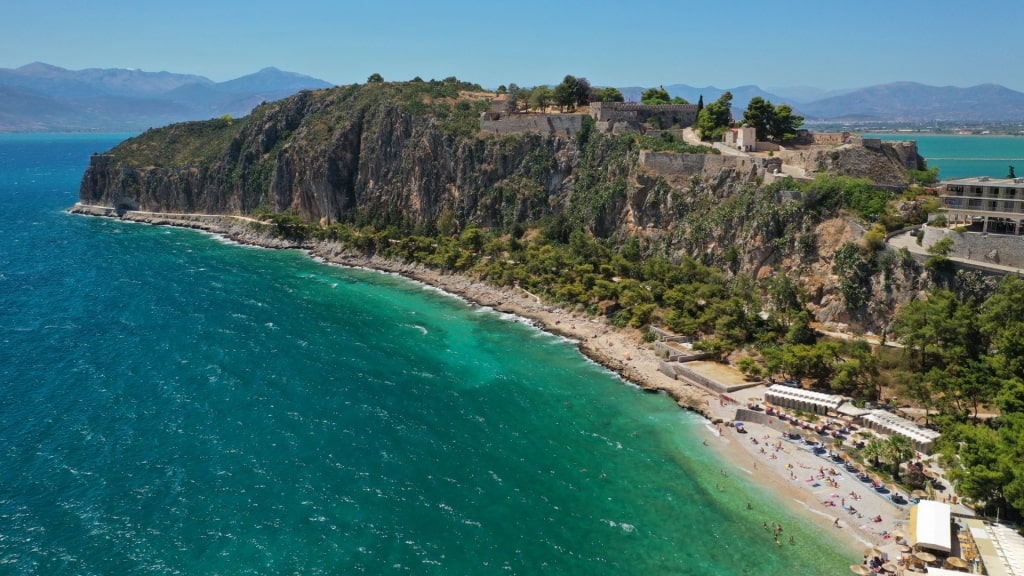
Arvanitia Beach, Nafplio
A former capital of Greece, Nafplio is an elegant port city overlooked by the imposing Palamidi, a hilltop fortress built toward the end of Venetian rule in the 17th century.
A coastal walk from the main town leads to a series of beaches of which Arvanitia is the best.
Nestled in a sheltered bay, this sand and shingle beach is backed by pines and has rocky outcrops at either side of the bay that are perfect for those looking to take in some snorkeling.
A couple of tavernas at either end are both great for a lunchtime mezze and an ice-cold beer, too.
Glyfada Beach, Corfu
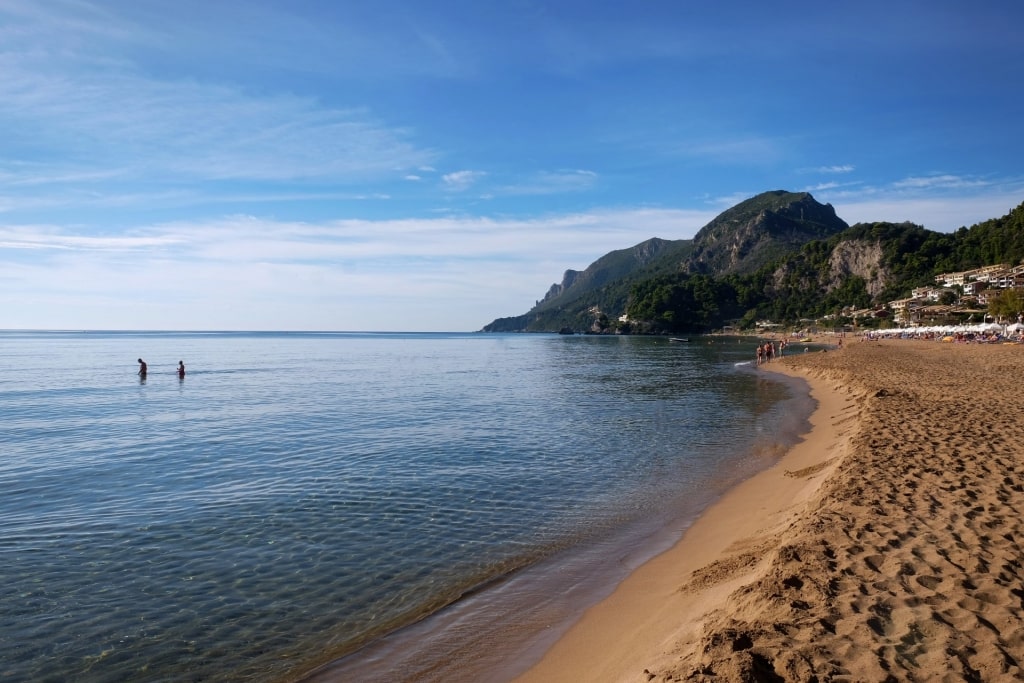
Glyfada Beach, Corfu
Not to be confused with the similarly named coastal suburb of Athens, Glyfada Beach is regarded as the best beach in Corfu and one of the finest Greece beaches.
Set across the island from Corfu Town and with never-ending views of the Ionian Sea, the wide, golden sand beach is backed by rolling hills topped with pine trees.
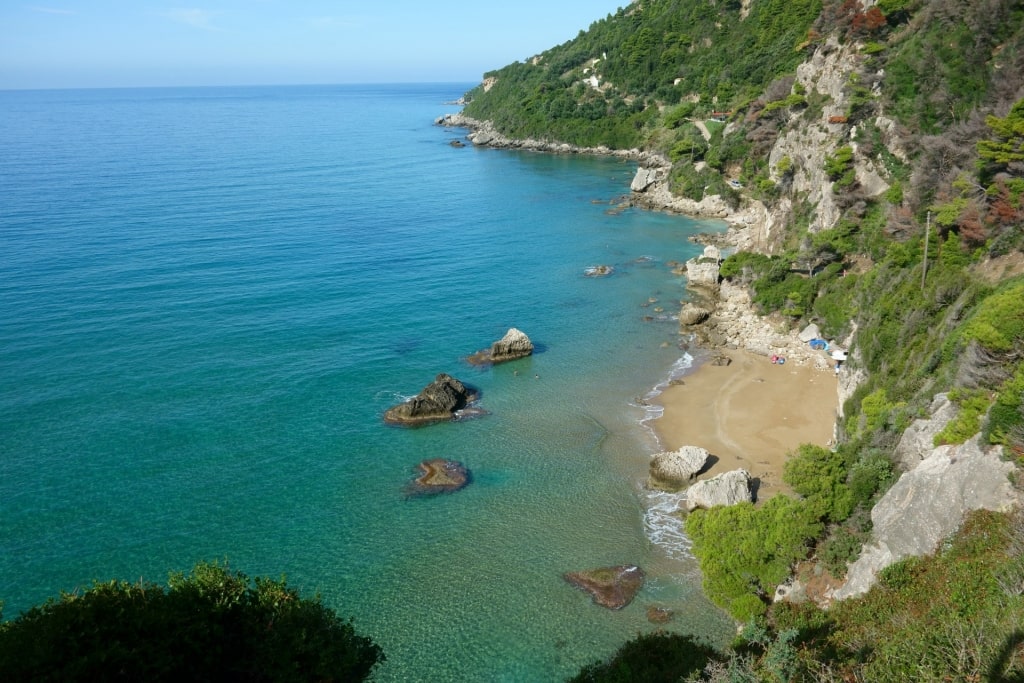
Mirtiotissa Beach
A handful of tavernas back onto the sands meaning there are enough umbrellas and sun loungers for all, and there are a number of walking trails through the woods too for those looking to explore further.
Mirtiotissa Beach, a five-minute walk away, is more secluded and is also clothing-optional.
Read: Best Beaches in Corfu, Greece
Kokkini Beach, Santorini
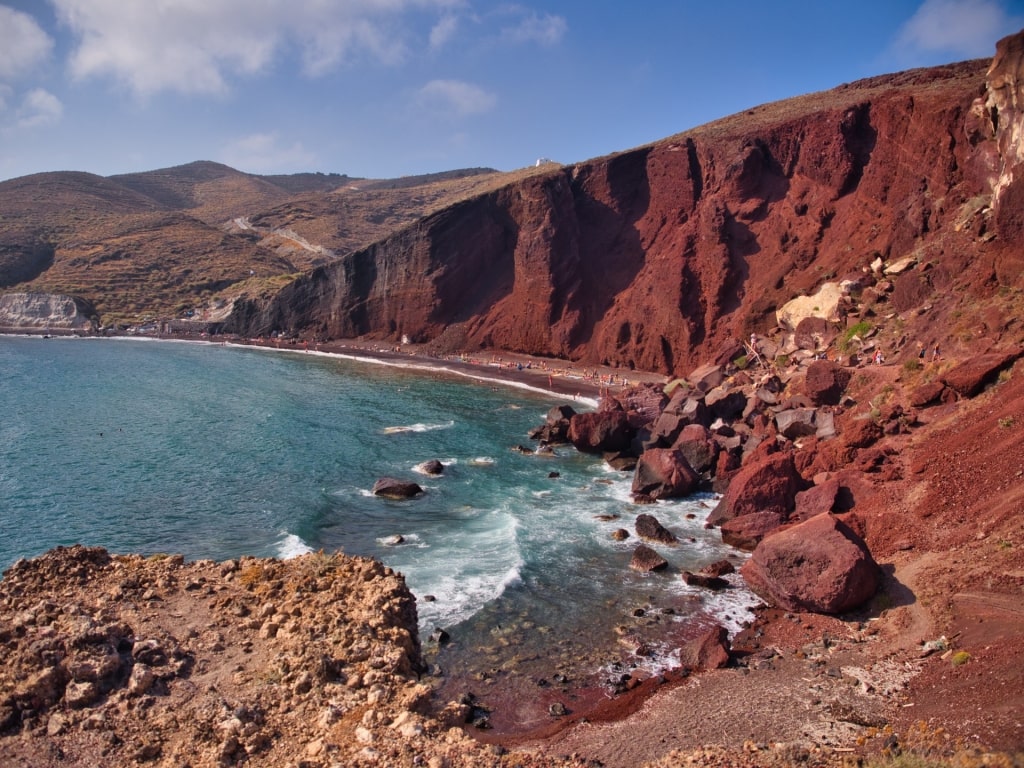
Kokkini Beach, Santorini
If Perissa Beach is famed for its black sand, Kokkini (or Red) beach stands out for the bright rust-colored rocks that surround it, some of which have eroded onto the beach to produce a vivid mixture of pink shades in the sand.
The beach here is ruggedly beautiful. Red rocks on either side of the main crescent have tumbled down to the shore, creating both natural windbreaks and snorkeling opportunities that make it one of the best beaches in Santorini.
There was a time when there was zero shade here, meaning visitors had to pack their own canopies, but the two cafés now have sunbeds and umbrellas providing welcome respite from the heat.
Agios Sostis Beach, Mykonos
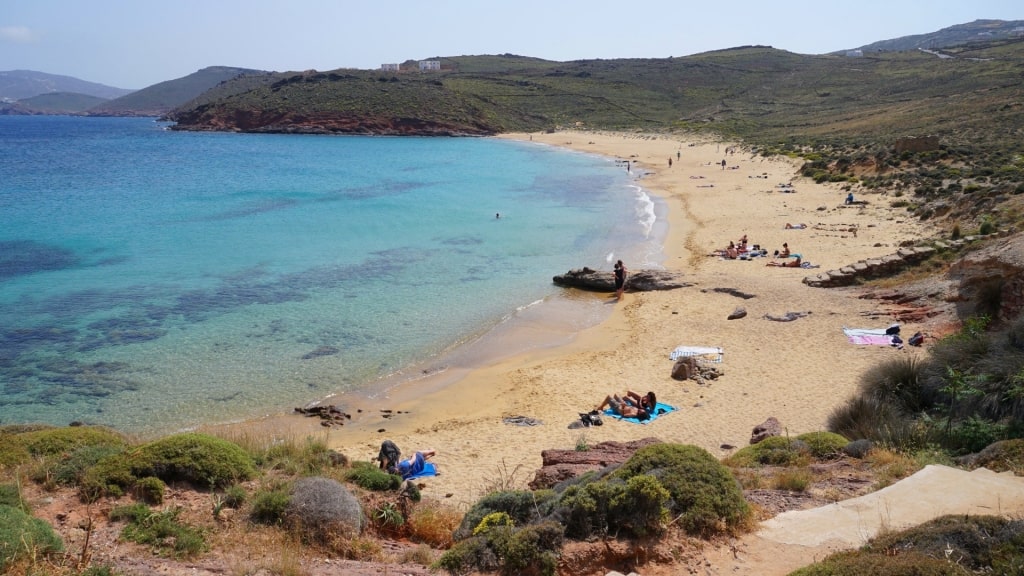
Agios Sostis Beach, Mykonos
If the lively lifestyle on the beaches of southern Mykonos is not your style, head north to this remote beach named after the small church that stands guard over it.
Even in high summer, this Mykonos beach is a back-to-basics beach. There are no sun loungers or umbrellas, just a wide arc of pale straw sand, wild and uncommercialized, gently lapped by the Aegean Sea.
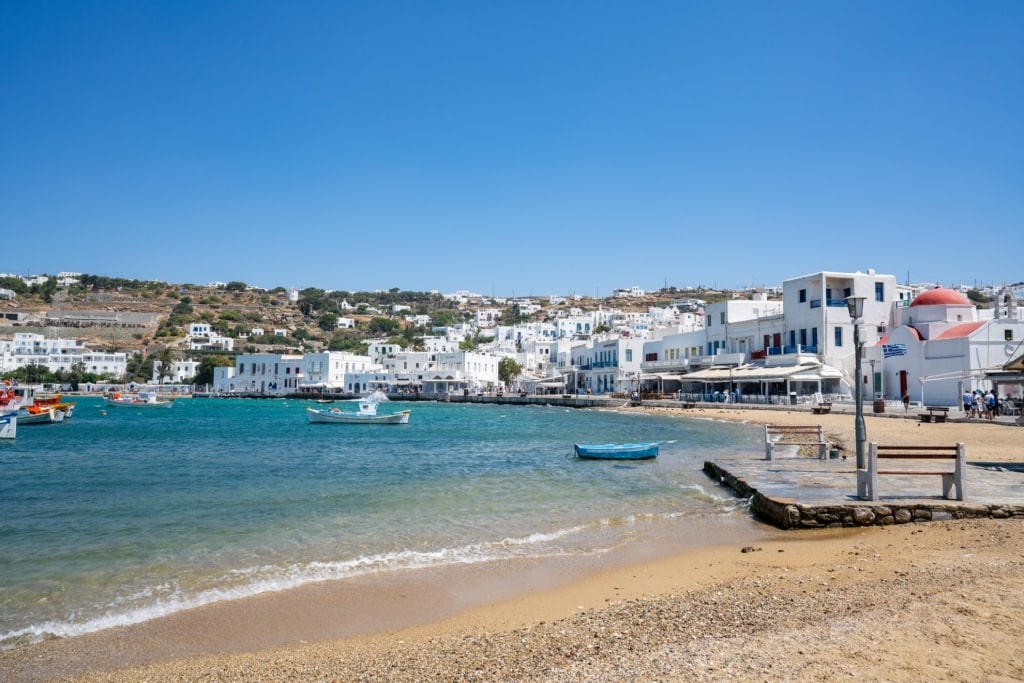
Mykonos Town
Pack a picnic purchased at the shops in Mykonos Town, or pay a visit to the solitary taverna, Kiki’s, in the adjoining village which has elevated views over the beach—a great location to while away the afternoon.
Read: Best Things to Do in Mykonos
Anthony Quinn Bay, Rhodes
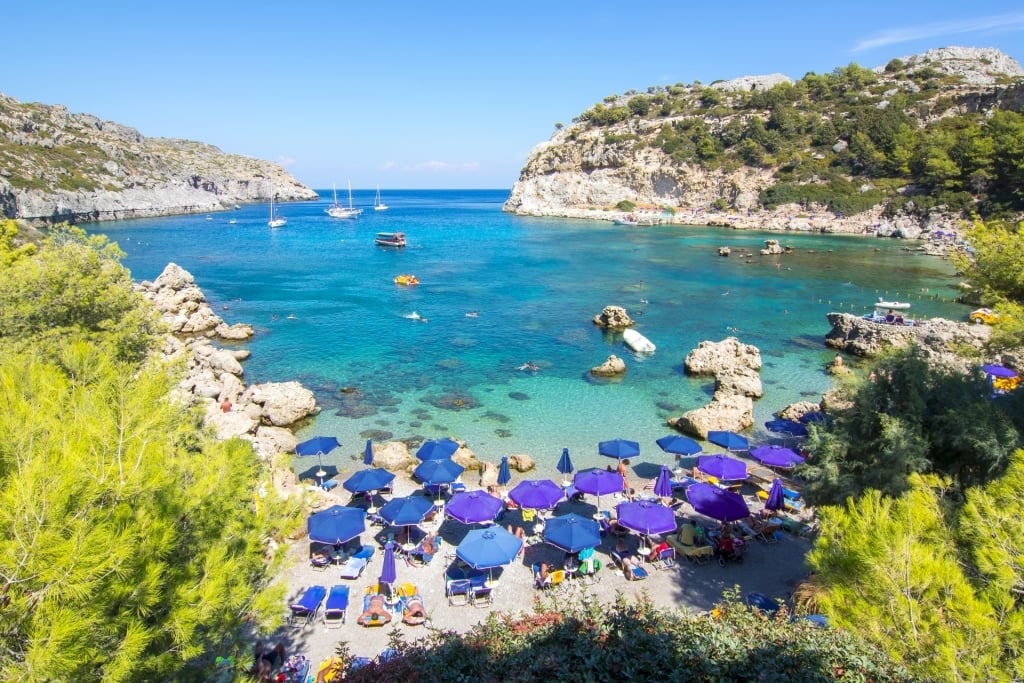
Anthony Quinn Bay, Rhodes
Faliraki Beach, some four miles of golden sand, is one of Rhodes’ best beaches but the town is undeniably busy, especially in the height of summer.
It’s worth following the coast road for another mile or two to find this lovely, secluded cove named after the famed Mexican-American actor who used to vacation here.
Surrounded by rugged rocks and dense vegetation, the beach is quite rocky, making it less amenable for children and those with mobility challenges. Still, the location and the snorkeling are second to none.
Epanomi Beach, Thessaloniki
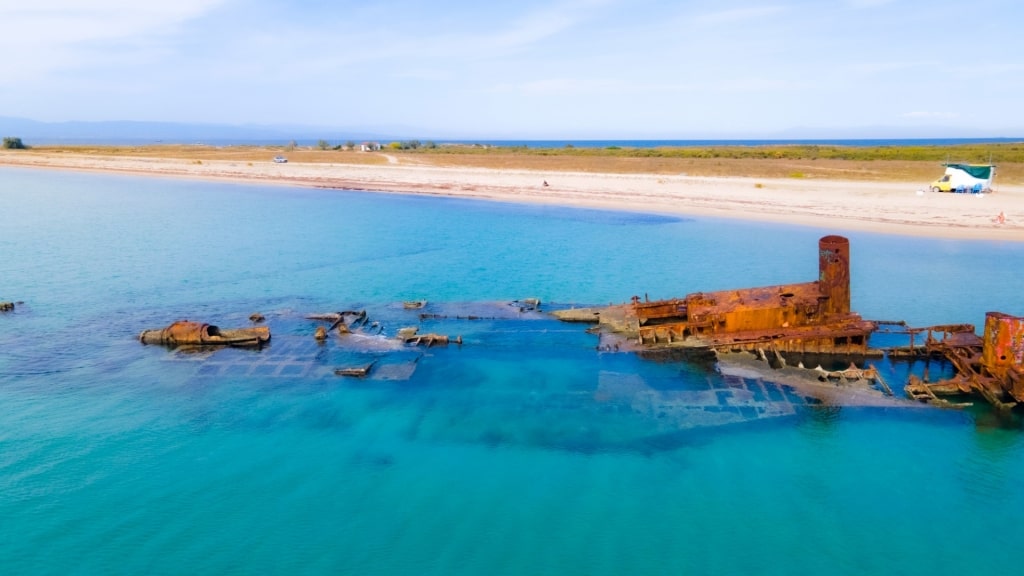
Epanomi Beach, Thessaloniki
Greece’s second city Thessaloniki is a fabulous melting pot of Byzantine history and contemporary culture that can keep you occupied for days.
Overlooking the Thermaic Gulf, the port frontage of downtown soon gives way to sleepier, more traditional summer resorts, particularly as you head southeast to the Halkidiki peninsula.
Less than an hour’s drive from the city lies this white sand beach on either side of a pointed spit that juts out into the gulf.
There are a couple of cafés along the beach, but few other facilities, so packing snacks and drinks is a good idea, as is carrying something under which to take shelter from the sun’s rays.
Read: Best Beaches in & Around Thessaloniki
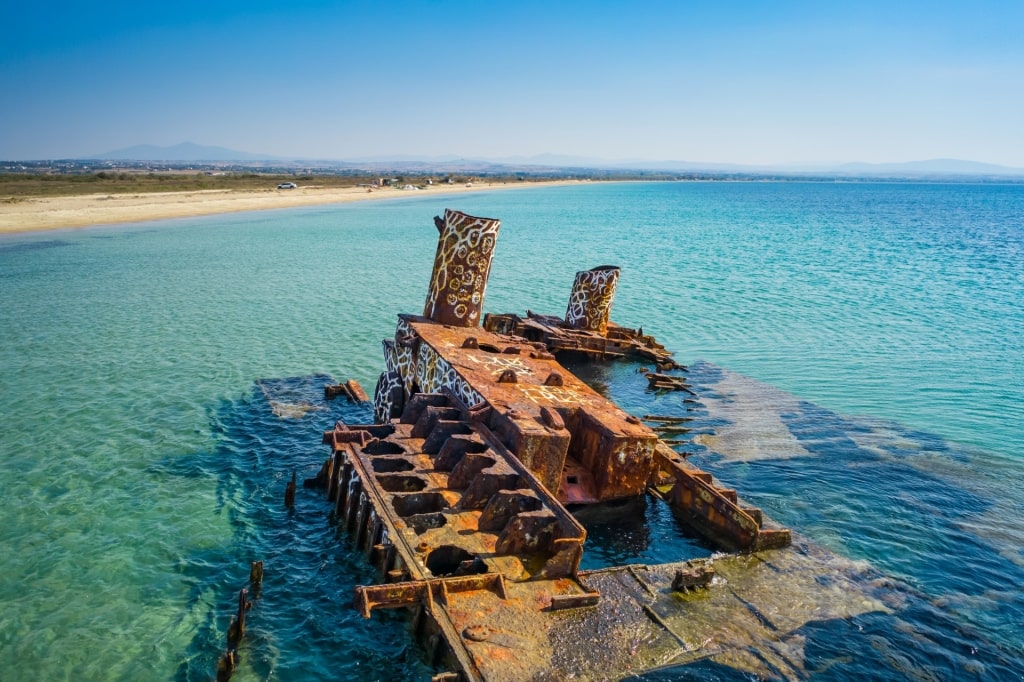
Epanomi Beach, Thessaloniki
The wreck of a cargo ship lies just offshore here. Sunk in 1970, it has since rusted and provides a focal point for swimmers who can reach it quite easily from the beach.
Sounion Beach, Cape Sounion
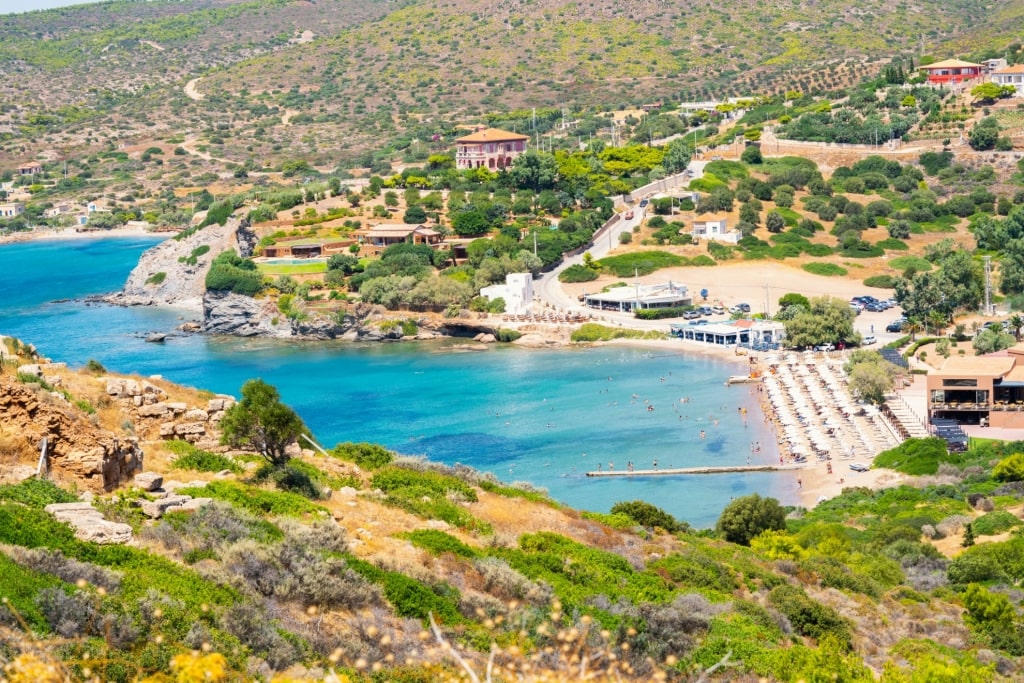
Sounion Beach, Cape Sounion
Around 35 miles from both downtown Athens and the port of Piraeus, Cape Sounion is the easternmost tip of the Athenian Riviera. It’s famed for the clifftop Temple of Poseidon that overlooks the Aegean Sea and is said to have some of Greece’s loveliest sunsets.
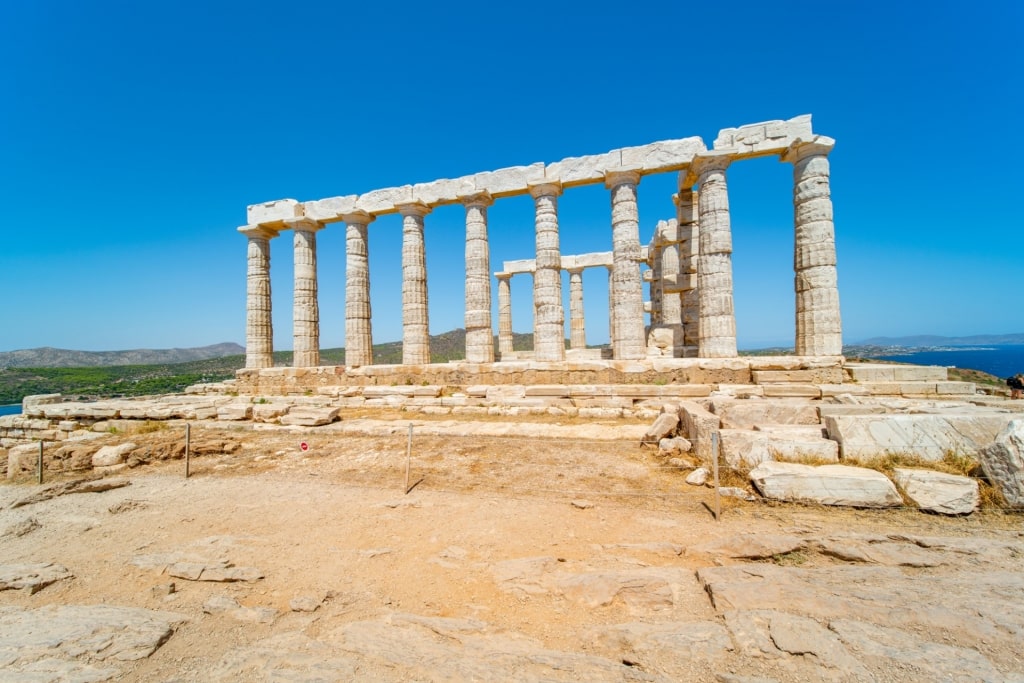
Temple of Poseidon
The temple overlooks some of the nicest beaches this side of Athens, and a visit here can easily be combined with some beach time.
The main stretch is partly reserved for hotel guests, with the rest open to the general public. Facilities are exceptional here with a couple of beach bars, a restaurant, and sunbed hire all available.
Vrasidas Beach, Kavala
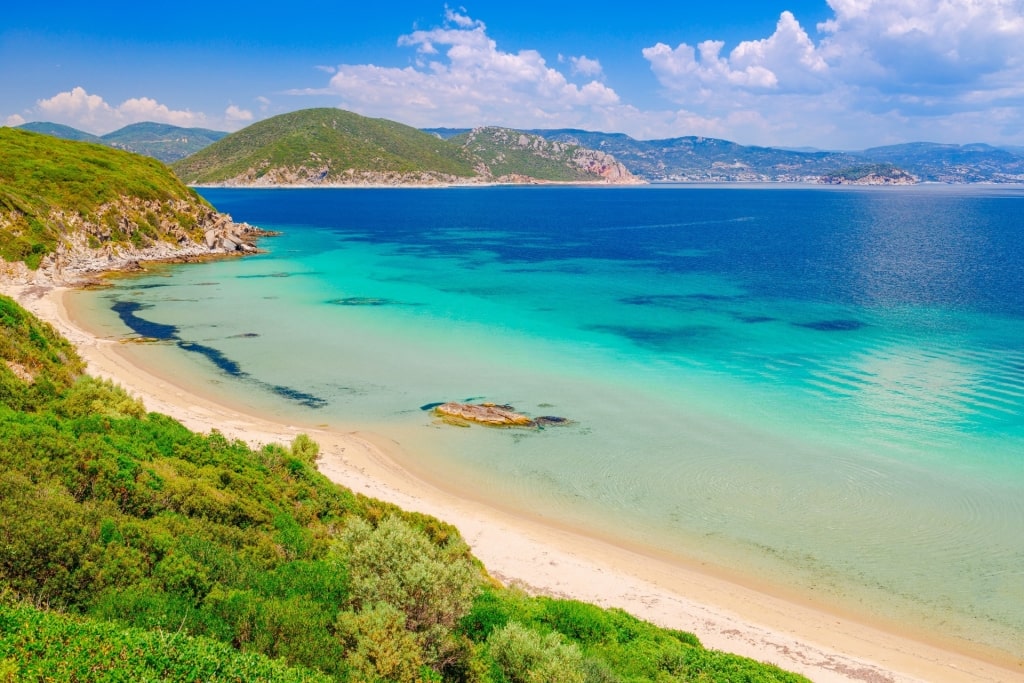
Vrasidas Beach, Kavala
Ask someone to sketch out their perfect Greek beaches and the result may be something that looks like Vrasidas. Set on a promontory just outside the resort of Nea Peramos and approached on a dirt road through olive groves, it consists of an almost perfect arc of golden-white sand with shallow waters that seem to get a deeper shade of blue with every step away from the beach.
Despite its proximity to the town, it still feels pretty remote. There are few facilities save for a single taverna that also offers the usual beach paraphernalia for hire.
Agioi Apostoloi Beach, Chania
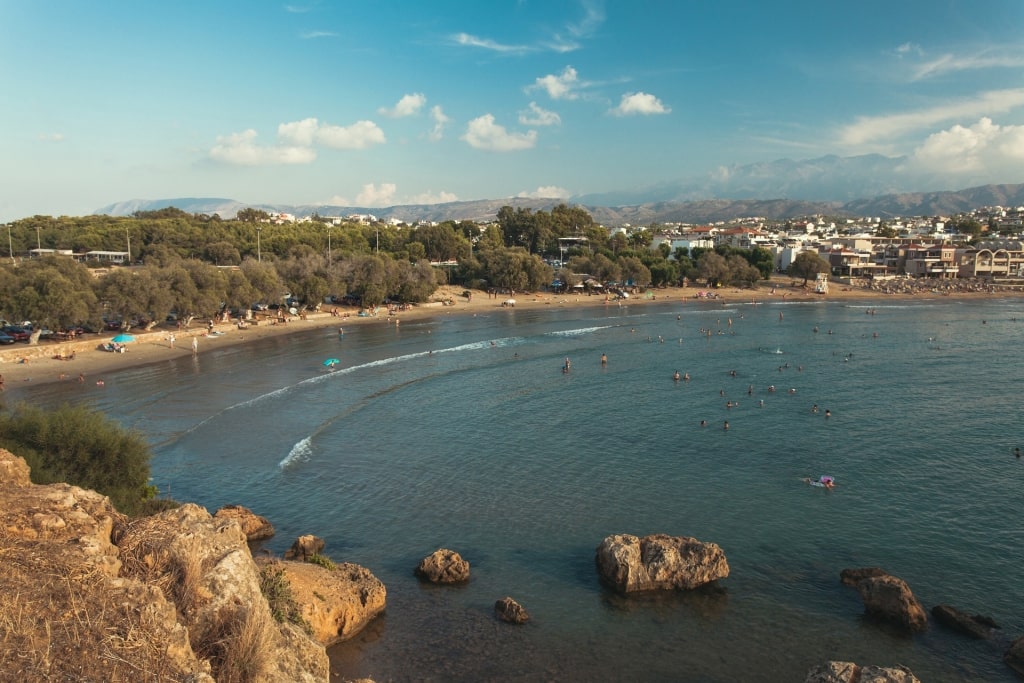
Agioi Apostoloi Beach, Chania
Such is Crete’s size, it is home to myriad amazing beaches, but for most of them you have to drive outside of the two large population centers of Chania and island capital, Heraklion. Not so with Agioi Apostoloi, a lovely stretch of sand less than two miles from the Old Venetian Harbor at Chania.
Visiting here is one of the best things to do in Crete. Popular during weekends, it is positively quiet during the week, even in high season, which means those that do visit can enjoy the long, curved arc of sand lapped by gentle waves almost to themselves.
The beach is protected from winds by the bay in which it sits. The water here also shelves off extremely gently, making Agioi Apostoloi a joy for those who are less confident swimming in the ocean.
Glyfada Beach, Athens
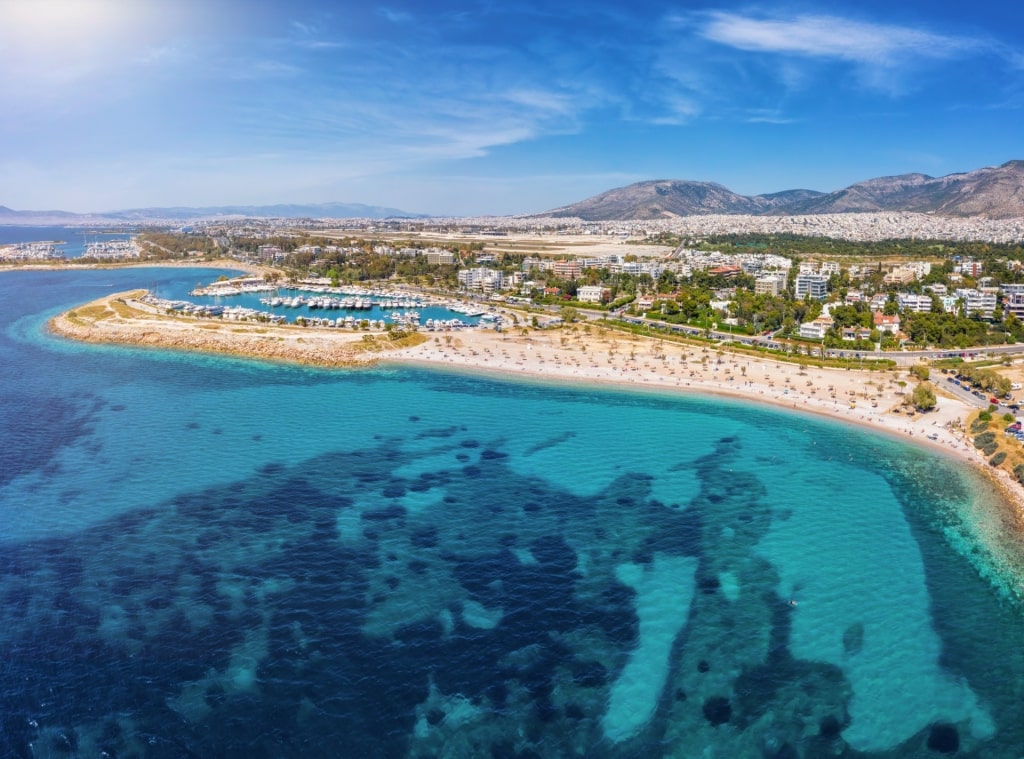
Glyfada Beach, Athens
Back in the 1950s, Glyfada began its transformation from small fishing village to the seaside resort of choice for Athenians escaping the city heat.
Such has its popularity grown, it is now the Greek capital’s largest suburb, extending far beyond the traditional square that is home to one of the town’s icons, the Church of St Constantine and Helen.
High-class restaurants and even higher-class shopping abound. Despite the main town’s commercialization, the beach remains somewhat a throwback.
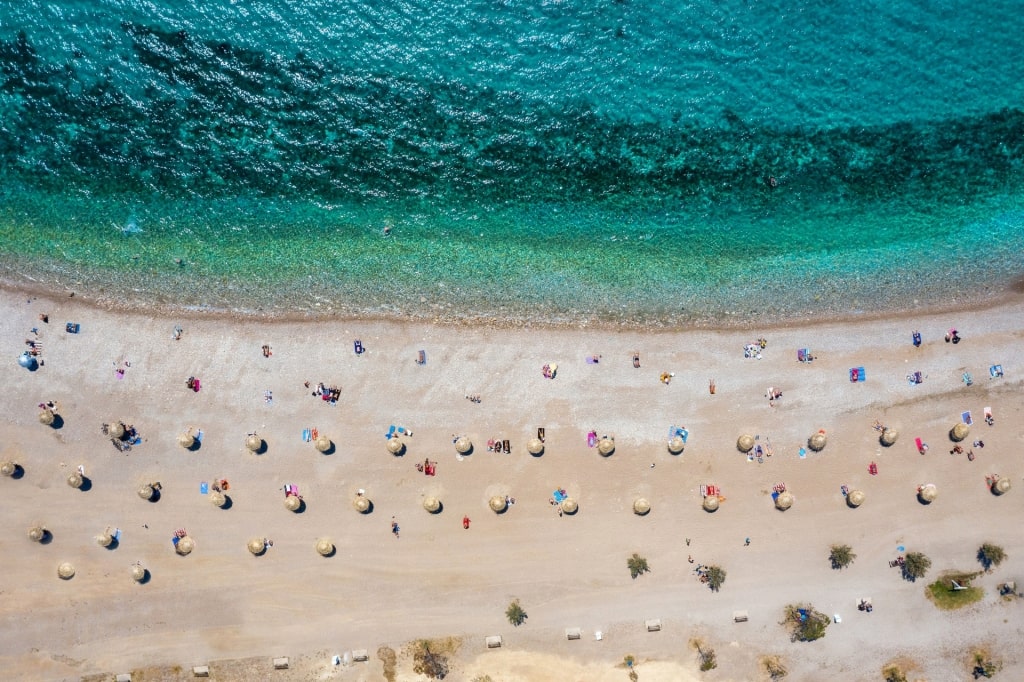
Glyfada Beach, Athens
Set around 10 miles from downtown Athens it is the first beach along the Athenian Riviera that Athenians would deem attractive enough to grace with their presence.
Nowadays, many city-dwellers head to the islands for their summer retreat. That means the shingle beach, dotted with free-for-use straw umbrellas, is usually super quiet, allowing visitors to take in the waters that overlook the island of Aegina in the distance.
Read: Best Things to Do in Greece
Canal d’Amour, Corfu
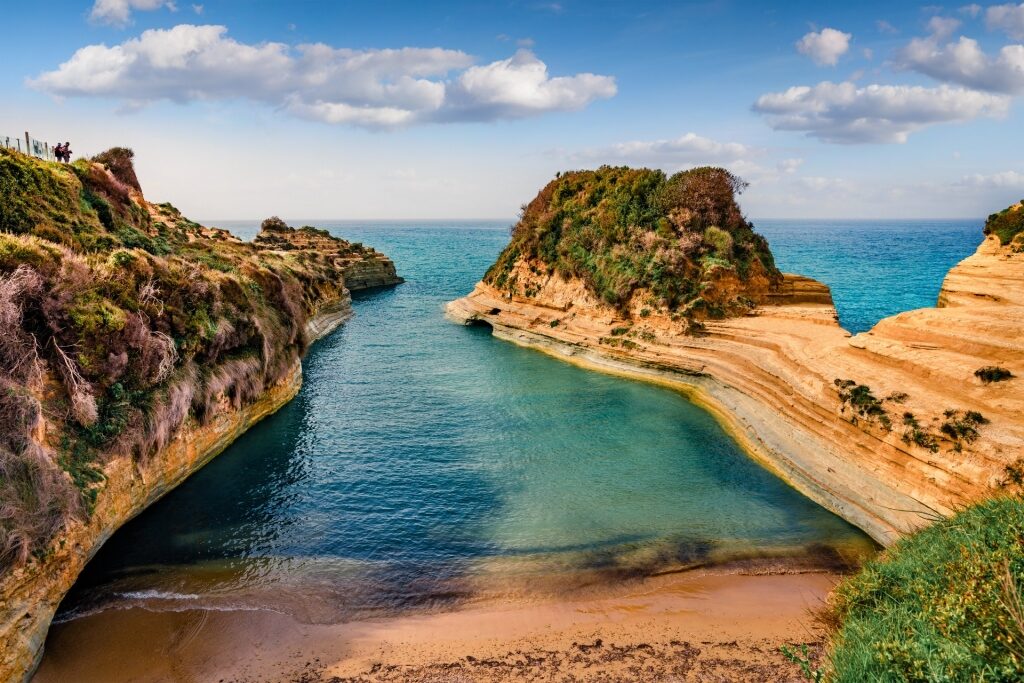
Canal d’Amour, Corfu
Nestled just beyond the charming village of Sidari on Corfu’s north coast, the Canal d’Amour (or Kanali tou Erota in Greek) is a quaint sandy enclave cradled by a dramatic split in the surrounding rock formations.
Translating to “Channel of Love”, this romantic Greek destination is home to a whimsical legend that claims that all men who swim here will find the love of their life when exiting the water.
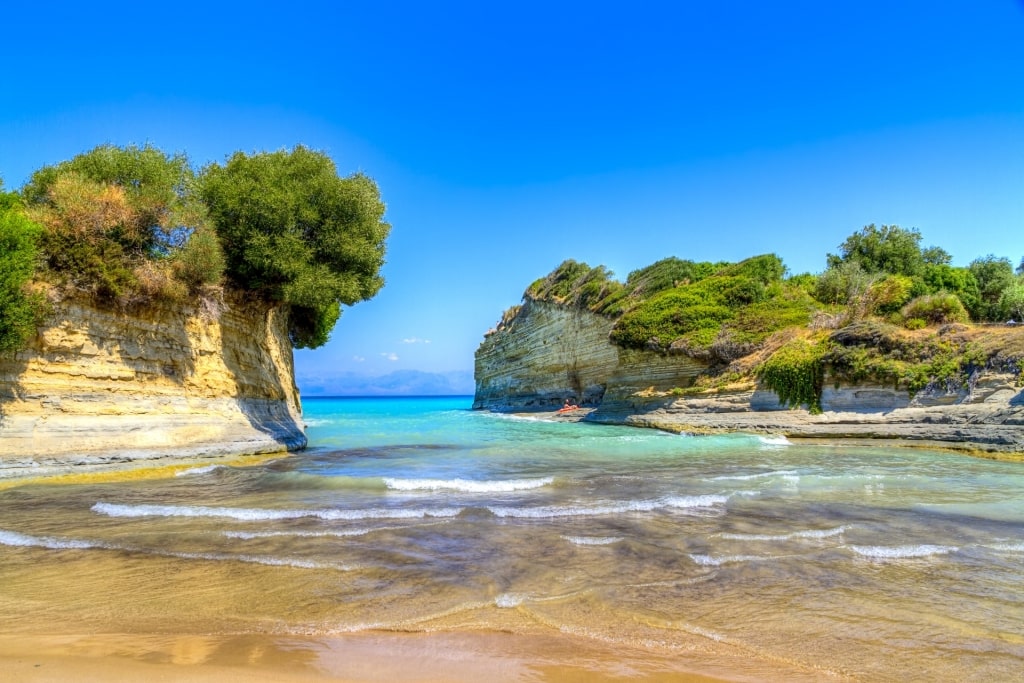
Canal d’Amour, Corfu
While the combination of local folklore and the bay’s dramatic beauty are a huge draw in the height of summer, the surrounding rocks offer plenty of space for sunbathing. There are smaller, less popular coves nearby that provide a quieter alternative when the main beach is too busy.
Elia Beach, Mykonos
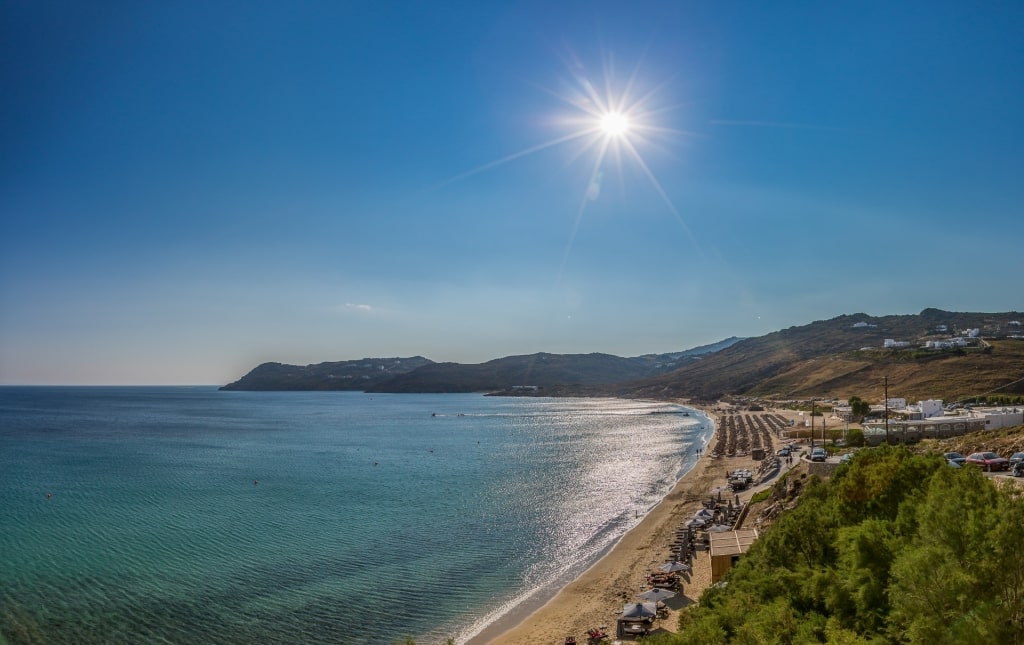
Elia Beach, Mykonos
Visitors need to pack a liberal attitude alongside their sun cream and water when visiting Elia Beach. Not only is it Mykonos’s largest beach, but it’s also home to a “live and let live” vibe on an island that is already as open-minded as they come.
The Rainbow flag that flies over the beach signals its friendliness to the LGBTIQA+ community that favors Mykonos vacations. It’s also the island’s most obviously clothing-optional beach.
Backed by rolling hills, the beach consists of an achingly long curve of pale sand kissed by the Mediterranean blue sea, while umbrellas and sunbeds are in abundance.
Limanaki Agios Pavlos, Lindos, Rhodes
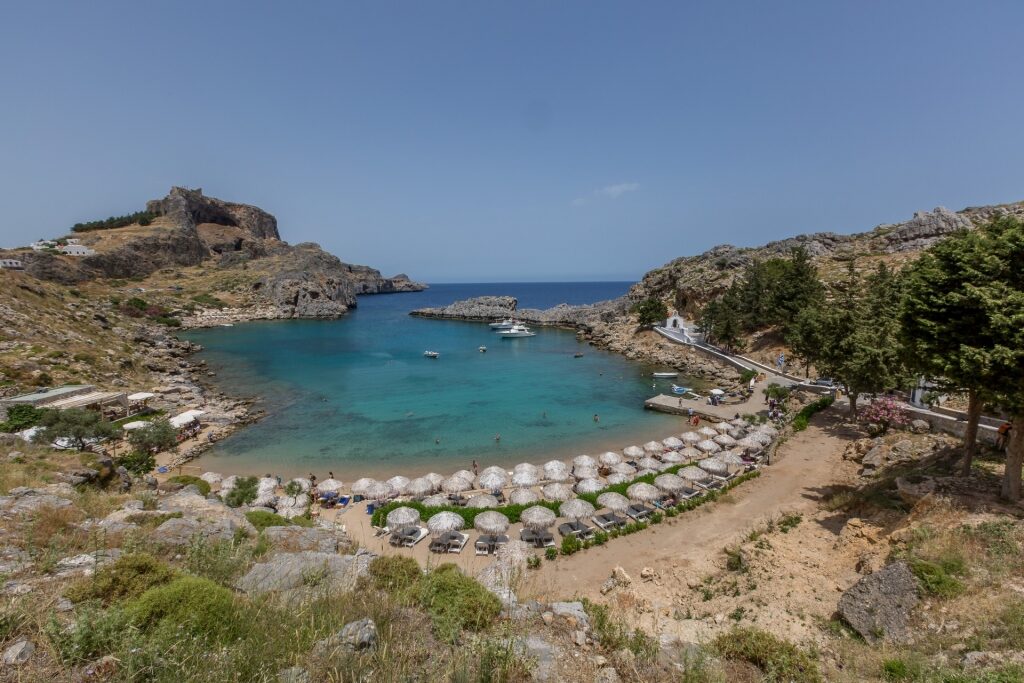
Limanaki Agios Pavlos in Lindos, Rhodes
The Greek islands are rife with myth and legend, none more so than Rhodes, home to the Crusader Knights Hospitaller who conquered the island in the 13th century.
The history of this jewel of the Dodecanese group runs even deeper than that, though. It is also home to the ancient acropolis of Lindos which overlooks the small bay of Agios Pavlos (St. Paul).
It is here that the apostle St. Paul is thought to have landed to preach Christianity in 43 AD and the rest, as they say, is history. Today, the beach consists of golden sands dotted with pebbles and surrounded by rocks from which many dive into the clear waters. There’s a chapel here dedicated to St. Paul, so perfectly bijou that it’s used for many a wedding.
Chorefto Beach, Volos
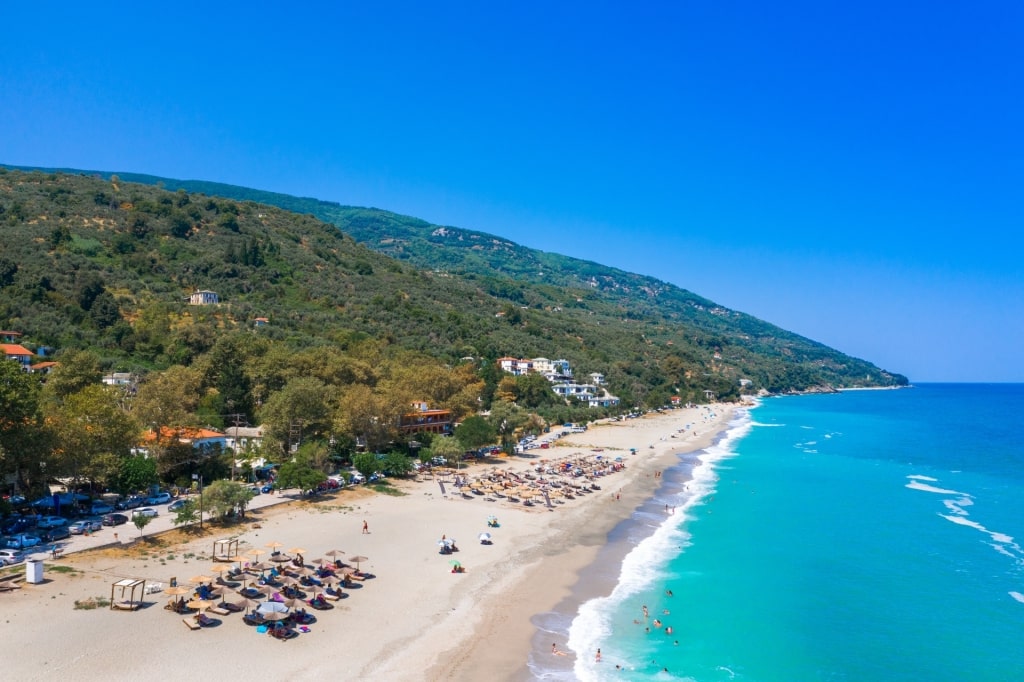
Chorefto Beach, Volos
Greece has its fair share of dramatic beaches. Many of them are clustered around the central Greek city of Volos thanks to towering Mount Pelion which overlooks both the downtown area and the surrounding east coast from 5,300 feet above sea level.
The beach at Chorefto is certainly one of the region’s prettiest, stretching for around a mile and a half and backed by the lush forests nestled in Pelion’s foothills.
Relaxed beach bars line the straw-pale sands, and there’s an old church called Agios Nikolaos that’s well worth a visit when in the region, built in the ruins of an ancient temple. Its walls are covered in some lovely frescoes.
Paleokastritsa Bay, Corfu
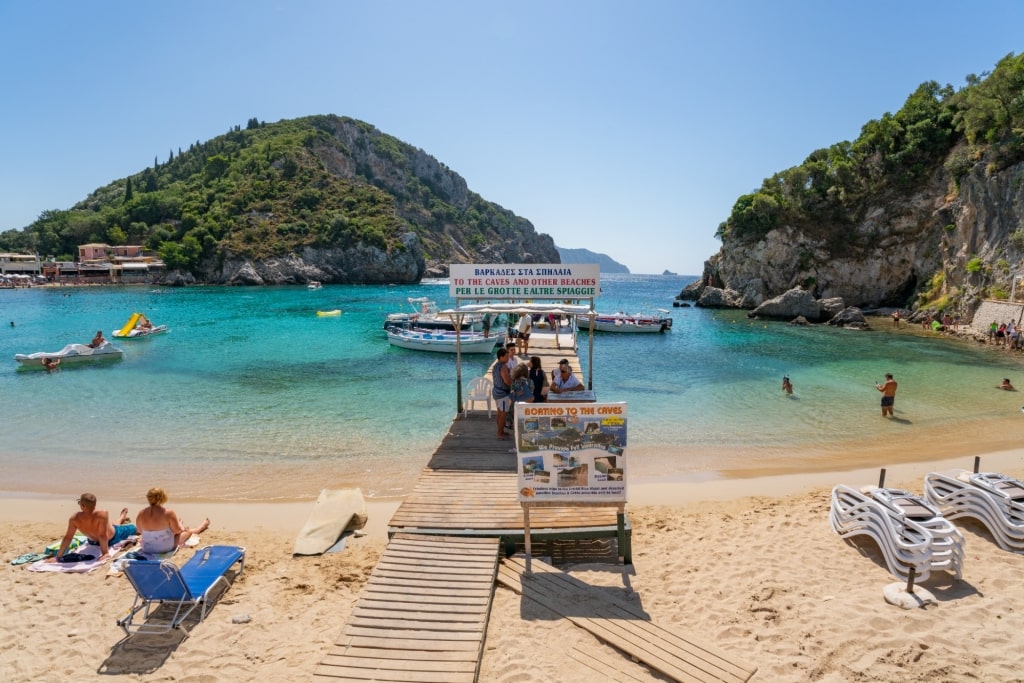
Paleokastritsa Bay, Corfu
Paleokastritsa Bay is home to two main beaches in Corfu, Verderosa and Agia Triada. The former is slightly more wild, rough and ready, while Agia Triada has great facilities including a number of beach bars as well as better sand.
Watersports lovers can enjoy great snorkeling around rock formations just off shore, and there’s a small jetty from which boats and pedalos can be hired.
The bay is redolent with local legend too. Many believe the town to be the home of the mythical Phaeacians whose lands provided the final stop on Odysseus’ journey in Homer’s classic text, The Odyssey,
Molos Beach, Hydra
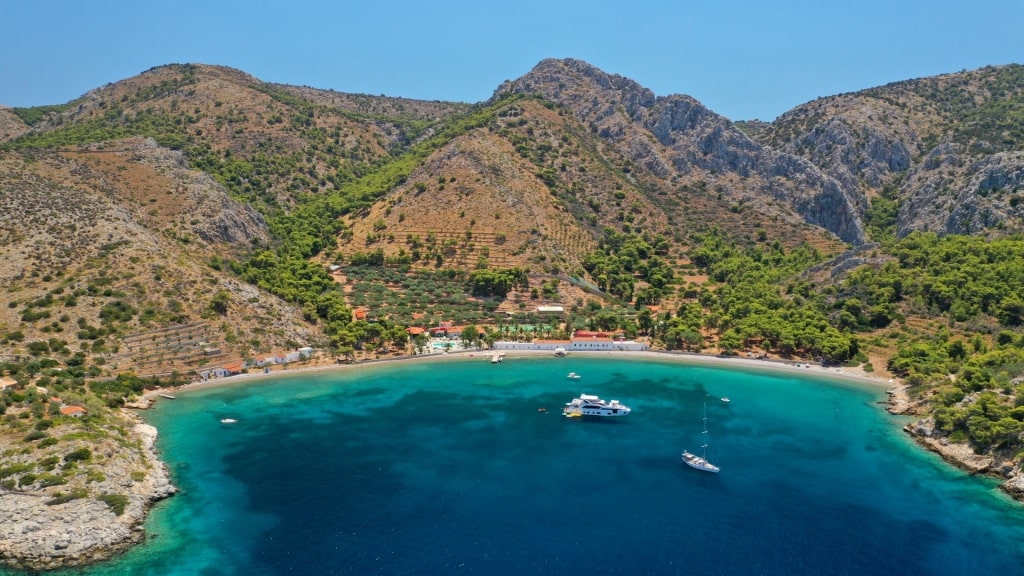
Molos Beach, Hydra
Overlooking the islet of Kivotos, Molos Beach lies about an hour’s walk or 15-minute water taxi ride southwest of Hydra’s port. One of the island’s most remote beaches, the long cove is covered with sand and bright white pebbles, and backed by a forest of Mediterranean pine trees set on rolling hills.
Given that this is one of the best beaches in Greece, it’s no surprise that a number of people have built luxury homes in the area, making this Hydra’s Millionaire’s Row. The beach is also used as a “secret” mooring point for many of the small yachts that sail around the islands of the Saronic Gulf.
Agios Andreas Beach, Katakolon
In ancient times, Agios Andreas, a few miles northwest of Katakolon, was the harbor for Ancient Olympia. While it may not play such a vital role in local life any more, it’s still well worth a visit.
The beach has a natural Instagrammable beauty as it’s backed by pine forests and has a natural curve of pale golden sand and lovely clear waters.
You’ll find several beach bars here that rent out umbrellas and sunbeds, while there’s a small play park to keep any young ones happy.
Fakistra Beach, Volos
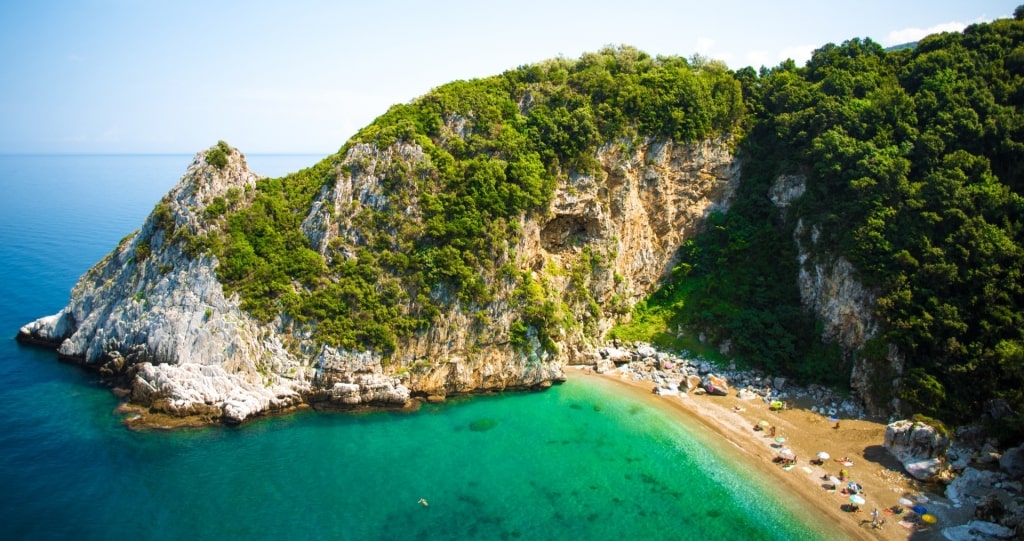
Fakistra Beach, Volos
Another dramatic beach on the eastern coast of Greece and close to the town of Volos is Fakistra. This spectacularly wild beach lies at the bottom of a 20-minute hike from the towering cliffs that surround it, but it is definitely worth the effort. At the bottom of the trail lies a short stretch of golden sand dotted with huge boulders and with water that’s as clear as glass.
A small river gorge also empties into the sea here and there’s the opportunity to take part in canyoning in the ravine, too.
Those daunted by the hike down and up can take solace in the ancient chapel that is carved into the rocks midway. Known as the “hidden school”, it offers the chance for mid-hike respite. There are no facilities at Fakistra, so visitors should pack for the day when visiting.
Ammolofoi Beach, Kavala
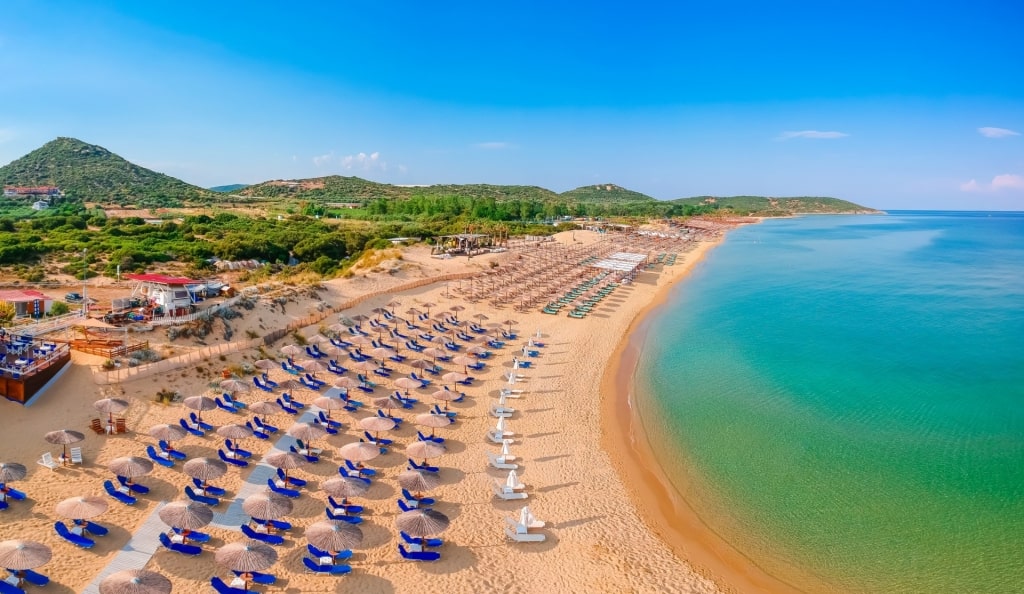
Ammolofoi Beach, Kavala
There’s a real Caribbean feel to the three Ammolofoi beaches that lay just a short drive southwest from the town of Kavala.
Ammolofoi translates as “sand dunes” and the beaches here consist of crisp white sand lapped by shallow waters of the deepest cyan, the island of Thassos and mysterious Mount Anthos on Halkidiki visible on the horizon.
Small, rocky headlands separate the three beaches. While bars, cafés and nightclubs dominate certain parts of the beach, the beach is so gloriously long that there are plenty of places to find solitude.
Tsambika Beach, Rhodes
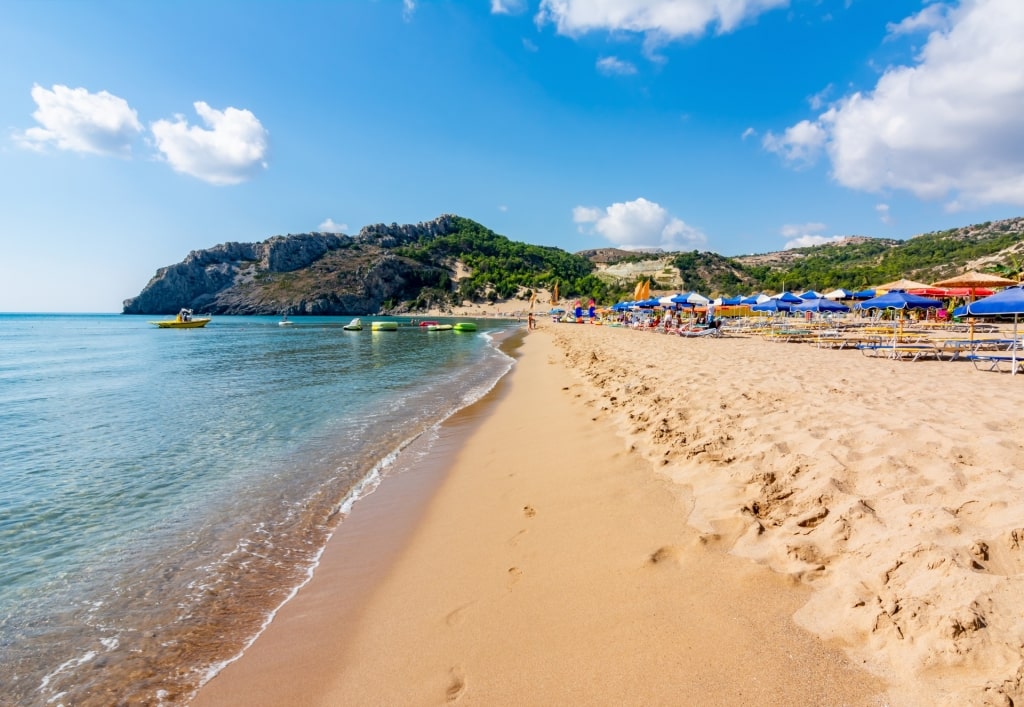
Tsambika Beach, Rhodes
A long and broad beach some 18 miles southeast of Rhodes Old Town, Tsambika’s golden sands and clear waters make it one of Rhodes’ more popular beaches.
There’s a mini market, a smattering of bars and a water sports center here, but aside from that there is little else of modernity to blight the landscape making the beach feel fairly remote, despite its popularity.
The beach takes its name from the eponymous monastery that sits on the surrounding hills and offers incredible views of the beach some 1,000 feet below. It contains a small Byzantine church dedicated to the Virgin Tsambika who, according to legend, is said to work miracles for those struggling to conceive.
Paraga, Paradise, and Super Paradise Beaches, Mykonos
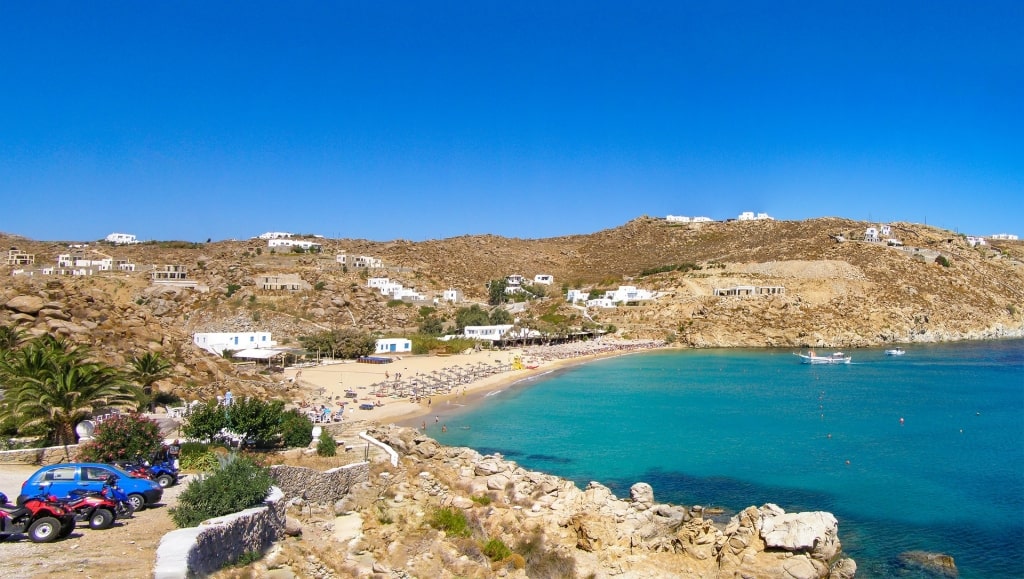
Super Paradise Beach, Mykonos
This string of beaches on the south coast of Mykonos are largely the ones that gave lie to the island’s party capital reputation.
Reached by water taxi from Mykonos Town, the beaches all have a similar vibe: arcs of golden sand backed by craggy rocks and clear waters. Not that many who visit do so for swimming, given the abundance of hip beach bars here.
The further one gets down the chain, the more raucous the atmosphere gets and for those looking to sample Mykonos’ unique party vibe by day (and into the evening), these are the places to visit. Keep an open mind, as anything goes here.
Agios Mamas Beach, Halkidiki
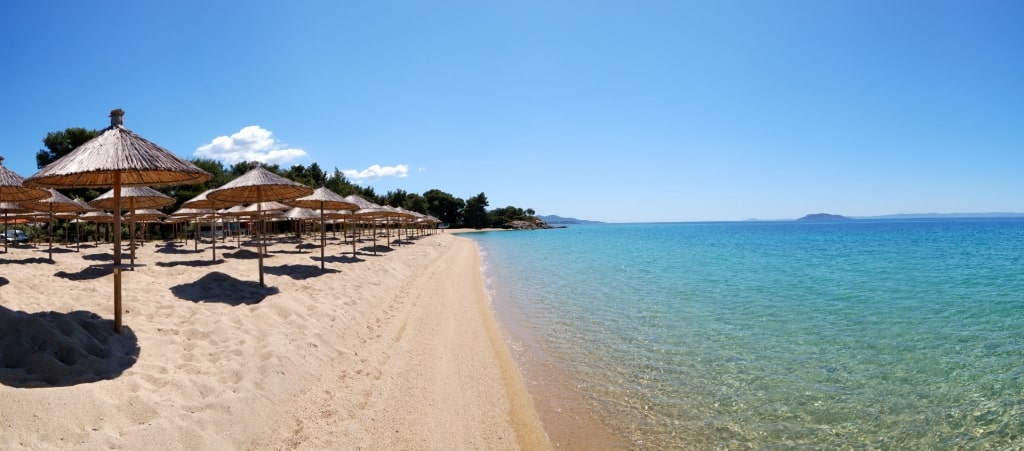
Agios Mamas Beach, Halkidiki
An hour’s drive southwest of Greece’s second city, Thessaloniki, lies the three-legged peninsula of Halkidiki, famed for its beautiful beaches. One doesn’t have to drive much further than the tip of the first leg, Kassandra, to find one of the region’s best, either.
Overlooking the Toroneos Gulf that separates Kassandra from neighboring Sithonia, Agios Mamas stretches for around two miles of narrow golden sand that hugs the wide arc of the bay and has calm shallow waters.
Such is its length that it never feels overcrowded and while visitors tend to migrate to several beach bars that line the sands, there are plenty of spots to find peace and quiet.
Aspri Ammos, Kavala
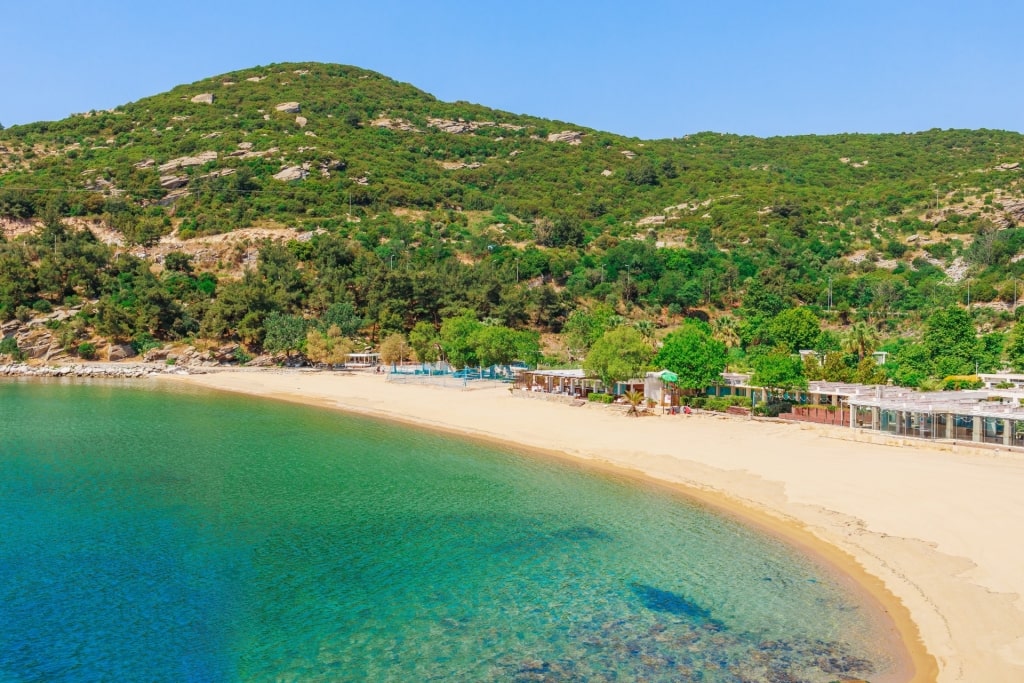
Aspri Ammos, Kavala
Some two miles to the north of Kavala lies this beach on an almost rectangular bay. Aspri Ammos means “white sands” and in the glaring sun of summer, it’s not hard to see where the name came from. Legend has it that the sand has a high mineral content and can be used for therapeutic purposes.
The sea water in the bay is clear and shelves gently away from the beach, while rocky outcrops either side of the bay and a sunken barge to the west make for great snorkeling. There’s also a beach bar with decent facilities, while the headland on which the beach sits has the ruins of several old fortresses.
Read:Tips for Planning a Trip to Greece
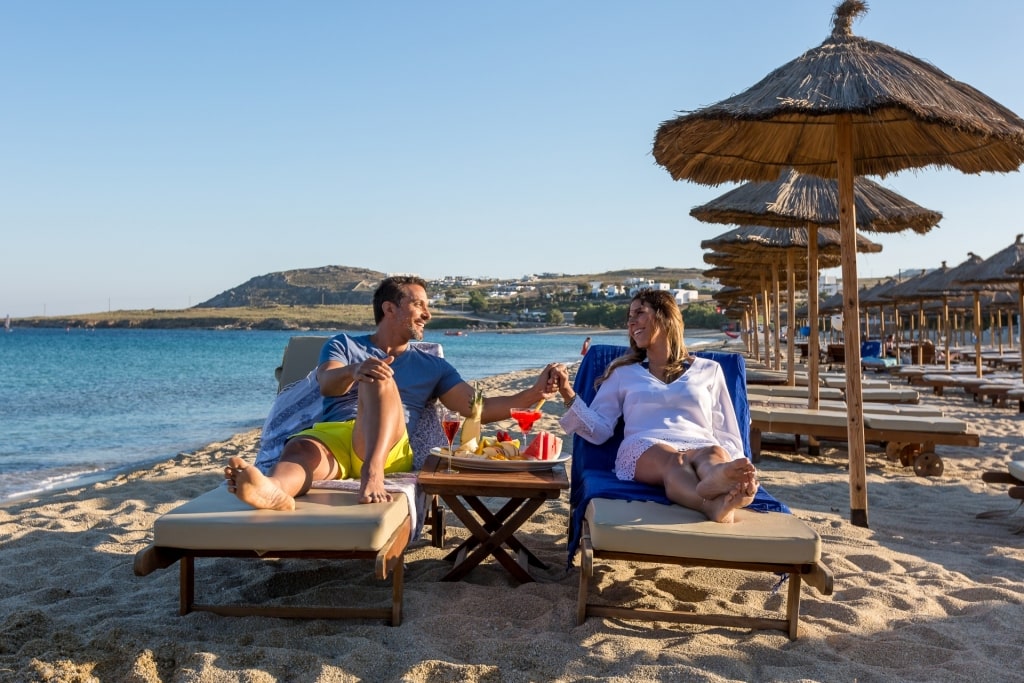
Mykonos
Are you dreaming of summer in the Greek Islands? Browse our Greece cruises and plan your Aegean odyssey.
